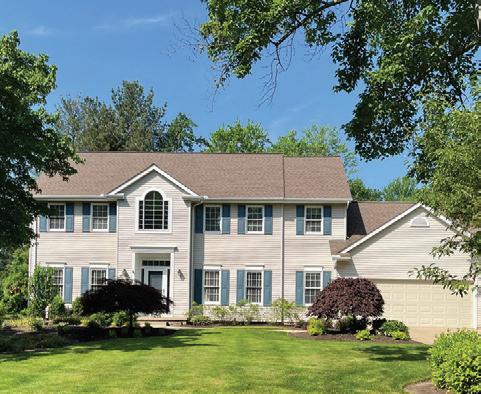










































































































A5 FASHION
Kent State Museum
exhibits collection from the estate of Katharine Hepburn
By Cynthia Schuster Eakin
A6 IN THE CLE Luxury dining, accommodations to be discovered, enjoyed at new Hotel Cleveland
By Sarah Jaquay
A8-9 TRAVEL
First of two stories
chronicling recent trip to South Africa
By Sarah Jaquay
C2 HISTORY
Gilded Age mansions being enjoyed today as fine dining establishments and Inns, places to stay
By Jeannie Emser
Schultz
C4-5 TITANIC EXHIBIT
Travel to COSI in CBUS to take in Titanic: The Artifacts Exhibit
By Linda Feagler
Submit nonprofit benefit events to editor@currentsnews.com.
Saturday, Aug. 10…New Moon Under the Stars, to benefit In Step With Horses, at Crystal Brook Farm, 19000 Snyder Rd., Chagrin Falls. The benefit supports equineassisted therapy and services for children and adults to improve mental health. Tickets are on sale at www.instepwithhorses.org.
Wednesday, August 21…Jam for Justice, to benefit Legal Aid, 5 to 9 p.m. at Tavern State. This annual summer fundraiser will include a staggered schedule of bands on two stages for non-stop fun! The event includes performances by 10 bands, all headlined by local bench and bar leaders – attorneys, judges, law faculty, & law students who moonlight as musicians and donate their talents to raise money for Legal Aid. Doors open at 5 p.m. with music by DJ Brad Wolfe, and the first band takes to the Tavern Stage at 5:20 p.m. Jam for Justice tickets are $60 each, and available online: lasclev.org/2024Jam All proceeds benefit The Legal Aid Society of Cleveland. Tickets are nonrefundable.
Saturday, Aug. 24…Rainbow Jumper Challenge, to benefit University Hospitals Rainbow Babies & Children’s, 5:30 p.m. at The Chagrin Valley Hunt Club, 7620 Old Mill Rd., Gates Mills. Equestrian jumping competition and exhibition with served cocktails, gourmet cuisine and a calcutta auction. Individual tickets will not be sold. Visit UHgiving.org/RainbowJumper for more information and sponsorship details.
Saturday, Aug. 24...2024 Summer Soiree: Bicentennial Bash to benefit Dunham Tavern Museum, 6 to 10 p.m. at the museum and grounds, 6709 Euclid Ave. As the oldest building in Cleveland, Dunham Tavern has witnessed 200 years of history. The evening will include live music, an open bar, buffet-style dinner and some surprises. Tickets start at $125. Visit http://www.dunhamtavern.org for details.
Sunday, August 25...to benefit the ICASI Scholarship Fund, 4 to 7 p.m. at ICASI, 8700 Mayfield Rd, Chesterland. Guests at Cleveland’s Top Chefs will enjoy small plates prepared by more than 12 of the top chefs of the Cleveland area. The event will be held in the classrooms and on the grounds of ICASI (International Culinary Arts & Sciences Institute) and will feature wine tastings, live music and raffles with the chance to win a trip for two to the wine regions of Italy led by Chef Loretta Paganini. Proceeds will support scholarships for culinary and pastry students. Reservations are $150 per person and can be made at icasischolarshipfund.org (Fundraising Events) or through Eventbrite.com.
Saturday, Sept. 7…Pandemonium 2024, to benefit Cleveland Public Theatre, at the Cleveland Public Theatre Campus. Event to honor with the PAN Award James D. Graham, Executive Vice President, Chief Legal and Administrative Officer & Secretary of Cleveland-Cliffs Inc. . Event to feature a labyrinth of theatre, dance, visual art and performances in every corner of the campus. Tickets will be available for purchase in July at cptonline.org. For more information, call 216.631.2727, ext. 120.

Northeast Ohio farmers report an early and hearty crop of many fruits and vegetables this year, due to warm winter and spring conditions. Farmers and other vendors from the Frostville Farmer’s Market suggest what to look for that’s in season for the next month or two on pages C4 and C5. Make an effort to visit a farmer’s market near you ~ buy local, buy fresh and support our hardworking area farmers.
The primary mission of Currents is to feature and spotlight the nonprofit, arts, educational and cultural organizations so vital to Northeast Ohio, as well as the volunteers and philanthropists who guide, support and sustain them.
P.O. Box 150 • Chagrin Falls, Ohio 44022 • 525 E. Washington Street • 440-247-5335 / Fax: 440-247-1606 www.currentsneo.com
Published monthly by the Chagrin Valley Publishing Company
H. KENNETH DOUTHIT III
Publisher
AMANDA MARRS
Creative Director and General Manager KELLI COTESWORTH MCLELLAN Editor
JULY EDITORIAL CONTRIBUTORS: Cynthia Schuster Eakin, Linda Feagler Sarah Jaquay, Rita Kueber, Jeannie Emser Schultz, Andrea C. Turner
PHOTOGRAPHERS: Peggy Turbett
ADVERTISING ACCOUNT EXECUTIVE S: Shari Silk
AD DESIGNERS: Connie Gabor, Ashley Gier
Please call 440.247.5335 for editorial, advertising and deadline information. Currents is distributed in: Auburn, Avon Lake, Bainbridge, Bath, Bay Village, Beachwood, Bentleyville, Bratenahl, Brecksville, Chagrin Falls, Chesterland, Cleveland Heights, Fairview Park, Gates Mills, Hudson, Hunting Valley, Kirtland Hills, Lakewood, Lyndhurst, Moreland Hills, North Royalton, Orange Village, Pepper Pike, Rocky River, Russell, Shaker Heights, Solon, South Russell, Strongsville, University Heights, Waite Hill, Westlake, Akron, Copley, Cuyahoga Falls, Fairlawn, Hinckley, Montrose, Peninsula, Richfield and Silver Lake.

By ANDREA C. TURNER
Entrepreneur, philanthropist, LGBTQ+ activist and art aficionado, Darl D. Schaaff has led an impressive life in his young 75 years. I met him inadvertently at the Cleveland Play House gala; he was decked out in a long black cape intricately decorated with gold accents, so he caught my attention.
Schaaff, a native of Findlay, Ohio, re-located to the Cleveland area from Alaska in October 2022, after his decades-long successful corporate event-planning business went under — due to the inability to gather because of Covid. Why Cleveland? Back in 2014, while working in Germany, he was tasked with conducting a site search here for the Gay Games, and awarded it to our fine city that year.
He bought the former Broadway Free Library, a decagon (10-sided) building at 5437 Broadway Avenue – only one of 10 like it in the country. In 1904, it was the first Andrew Carnegie library built in the city of Cleveland and donated to its residents. After closing to the public in 1987, it had been

Barbara Bachtell, Executive Director of Broadway
Darl Schaaff, owner of The Darl Center for the Arts are helping to revitalize Cleveland’s Broadway and Slavic Village neighborhoods
in disrepair, with a collapsing roof. Schaaff claims workers removed 120 cubic yards of garbage from the interior before renovations could begin in 2023.
Now, the building has found new life as the Darl Center for the Arts. It continues to
undergo changes to meet its plans for the future, including developing an alternative space to explore, create and present original works of art. The goal is to encourage and promote artists, and provide community space to share their experiences.
The Broadway historic district was once the largest business district in Cleveland, outside of downtown. Many of its original buildings still stand.
The walnut wood of the grand staircase is original, as is the sign in the first-floor bar area. The phrase, “On:Bookes:For:To:Rede:I:Me:D elyte” from Geoffrey Chaucer’s, “The Legend of Good Women” is carved in it. The first floor is equipped with a commercial kitchen, in which caterers can prepare food for special events. So far, the Cleveland Foundation has hosted a private event here, with likely more to come. An adjacent parking lot fits 50 cars.
Schaaff’s background is one that could be made into a multi-chapter memoir. He grew up studying ballet in Florida and studied briefly with ballet legend Robert Joffrey. After an injury, he took up martial arts and eventually


became a black belt winning multiple worldwide competitions. A picture of him shaking then President Bill Clinton’s hand hangs on the wall. He used his expertise to create a video series for LGBTQ+ individuals in the 1980s on how to protect themselves from physical violence. As an Executive Director, he led an Arts Festival in Alaska, brought young people with learning disabilities to perform at The Kennedy Center for Performing Arts in DC, met actress Elizabeth Taylor, and hung out with Andy Warhol. He also worked in Paris for 15 years.
A tour of the museum would not be complete without Schaaff’s personal stories behind each piece of art. Some were gifts, some he made, others were from events he planned across the globe or collected from his travels. One of the events he’s most proud of is the 50th Anniversary of the Statehood of Alaska in 2009, when he served as Executive Producer for a concert at a former WWII airplane hangar turned sound stage. It featured country music family the Judds and was viewed by 11 million people through subscription TV.
Schaaff’s life’s collection features intricately carved furniture from Asia, costumes from the Peking Opera, traditional African art, modern art paintings recently exhibited at Cleveland’s MOCA, a replica of the arch in Alaska for the Iditarod dog races in Anchorage, and much more.
The chrome steel tree featured in the building’s rotunda was constructed of materials leftover from a friend’s nightclub— stripper poles and kick rails. His corporate client, BP, commissioned it for an event signifying their success with the Alaskan gas pipelines. Schaaff was pleased he was able to hire a welder by trade to construct it, who happened to be transgender.
His life partner of many years in Seattle, Rick Leman who died after contracting AIDS, was a talented artist himself. A section of the museum’s collection features his work. The library’s former children’s room features colorful costumes collected from theatrical performances, as well as robotic puppetry, glass-blown art, and a neon 1969 sign in honor of the Stonewall Riots which served as a catalyst for the gay rights movement in the United States. It also includes a 10-foot papier-mâché fish. Several school groups have toured the space, and the kids, unsurprisingly, were in awe.
Downstairs, the renovated ballroom boasts a long cocktail bar, full stage with acoustic sound system, dance floor, raised seating area, and renovated restrooms. Currently, he rents the space to a swing dance group that gathers regularly to dance with a live band. In 2025, he’s planning an Art Quilts & Fiber Art show. To contact Schaaff about space rental or for private group tours, email darl@darlcollection.
100 Women Strong OHIO celebrated six years strong by granting monetary gifts to six deserving charities serving women and children throughout Northeast Ohio. As a beautiful evening unfolded, more than 100 Women Strong OHIO members and their guests listened to presentations by six charities, each of which has been the recipient of grant money during the giving circle’s bi-annual giving events. From human trafficking victims (RAHAB) to special needs kids (Empower Sports) to women in substance abuse recovery (Edna House) to homeless families (Family Promise) to the homeless on the streets (Akron Snow Angels) to kids graduating out of foster care (Chair-ity), the impact of these grants has been substantial and far-reaching. Not one of these charities knew that they would be receiving additional grant money before the announcement was made with much fanfare as is deserving of an event like this. The additional grant money was made possible through a generous donation by Ken Ganley Subaru which designated 100 Women Strong OHIO as the car dealership’s charity of choice during the annual Subaru Share the Love® event.
By CYNTHIA SCHUSTER EAKIN
“The Hepburn Style: Katharine and Her Designers,” the current exhibit at the Kent State University Museum, is a window into the glamour that was Hollywood in its heyday.
The museum’s collection includes the estate of Katharine Hepburn and her theatrical costumes throughout her career, as well as some personal items.
Academy Award-winning actress Katharine Hepburn left the New York stage for Hollywood in 1930. The rise of movies offered audiences an affordable form of escapism from the Great Depression, while costume designers delighted movie-goers by creating glamorous costumes worn by stars like Katharine Hepburn. The costumes were fashionable, contemporary garments that blurred the line between costume and fashion. Women in audiences wanted to emulate the styles they saw. Hepburn’s style was often perceived as a combination of her on-screen costumes and her personal fashion taste and has been described as, “all-time movie chic,” as well as, “easy, un-self-conscious and American.”
As an actress, Hepburn worked with costume designers, always pushing for comfort, movement and proportions that complemented her. Costume designers incorporated these elements into their designs, which blended Hepburn’s personal style preferences with their costume designs. The Kent State exhibition showcases Katharine Hepburn’s style with examples from her personal wardrobe, costumes, and the contemporary designers that she wore.
“This exhibition is a great opportunity for us to display some of the most popular pieces in our collection,” Sara Hume, professor and curator for the Kent State University Museum said. “We have had tremendous response with past exhibitions of Hepburn’s costumes and ‘The Hepburn Style’ allows us to showcase pieces that haven’t been displayed as well as to contextualize her wardrobe with garments from our collection by designers that Hepburn admired.”
According to Joanne Fenn, Kent State University Museum collections manager and curator of “The Hepburn Style,” the university acquired Hepburn’s stage and screen costumes, as well as pieces from her personal wardrobe, from the estate of Katharine Hepburn. “The former KSU museum director, Jean L. Druesedow, had been acquainted with the estate’s executor through a mutual contact. Jean worked with the executor and the bequest was finalized in 2012,” she explained. Hepburn died in 2003.
“There was one exhibition curated by Jean L. Druesedow, ‘Katharine Hapburn: Dressed for Stage and Screen.’ The exhibition was shown on two separate occasions at the Kent State University Museum. The exhibition also traveled to 10 venues across the country,” Fenn said.
Katharine Hepburn was born in Hartford, CT in 1907. In 1913, her family acquired a summer home in the sparsely populated borough of Fenwick, in Old Saybrook, CT. The property was a family retreat for years and became her East Coast residence where she enjoyed relaxing with family and friends.
Katharine Hepburn dressed more casually in private than for public occasions. However, she maintained similar standards for her casual wardrobe. She invested in quality, basic pieces, seeking fine fabrics, a tailored fit, and proportions
Submit nonprofit benefit events to editor@currentsnews.com.
Tuesday, September 10…Cross Out Cancer, to benefit immunotherapy cancer care and research in memory of Mary Ann Cross. Join leaders from University Hospitals Wesley Center for Immunotherapy at Seidman Cancer Center & Angie Fowler Adolescent & Young Adult Cancer Institute at Rainbow Babies & Children’s, 5:30 p.m. at The Shoreby Club, Bratenahl, 44108. Enjoy a stunning sunset while sipping cocktails and samplings of exquisite wines on the shore of Lake Erie, followed by dinner, live entertainment. The evening will showcase cutting-edge immunotherapy clinical trials and celebrate the pediatric, adolescent and adult patients benefiting from this life-saving care and research. The evening includes a stellar silent auction. Complimentary valet parking. Sponsorships, tables and tickets available. Contact Sharon. klonowski@uhhospitals.org.
that were complementary, Fenn said. Her uniform consisted of pants and a blouse or turtleneck, sometimes topped with a vest, jacket or another sweater around her shoulders. Fenn noted that many of the pieces in the gallery are well-worn with visible hand repairs indicating repeated use over the years, as well as a sustainable approach to dressing.
“This exhibition focuses on the public-facing Hepburn by looking at the designers she worked with on stage and at MGM studios, including Valentina, Adrian and Irene. In addition to featuring garments from Katharine Hepburn’s personal collection, this section of the exhibition showcases several Kent State University Museum collection items by these designers,” she said. “The second part of the exhibition focuses on Katharine Hepburn at home and features garments she wore privately.”
“There is a beautiful red pinafore overdress that is being exhibited for the first time, and it is a striking ensemble designed by Valentina. While Katharine Hepburn preferred muted tones, like tan pants with a black blouse, she consistently chose red when she did wear color. This pinafore dress is a gorgeous example of that,” Fenn said. “Likewise in her personal life, she consistently chose to wear a red turtleneck tied around her shoulders. For me, I enjoy seeing how she incorporates red in her
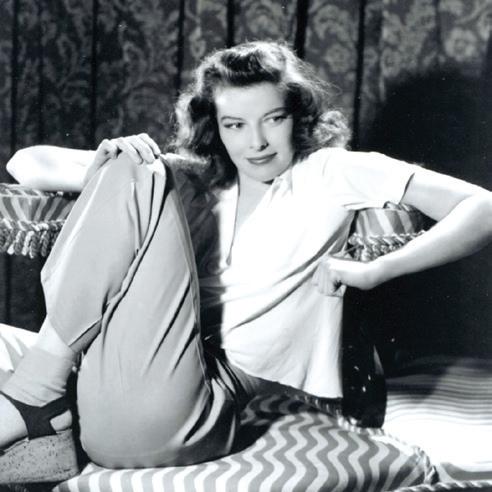
The Kent State Museum exhibition showcases Hepburn’s personal wardrobe, including her frequent choice of pants and a simple top.
wardrobe, and that is reflected in the exhibition.
A surprising element is that she wore many of her favorite items until they were frayed and she repaired them. There is a blue and white striped, cotton men’s shirt that is well-worn and repaired. The shirt must have been very special to her to have saved it despite its poor condition.”
Katharine Hepburn understood how to maintain the public’s interests for decades, not just through her career choices, but by providing access to her seemingly private world. Through biographical books and various magazine spreads, she crafted what the public saw, Fenn noted. Finally, she saved costumes and garments that were worn throughout her lifetime and career, only permitting the collection to be bequeathed to an educational institution. This collection provides for continued dialogue and interpretation of Katharine Hepburn, including her style and impact on fashion and society, Fenn said.
The Kent State University Museum is at 515 Hilltop Drive, at the corner of E. Main St. and S. Lincoln St. in Kent, OH. It features more than 29,000 pieces in its collection, amassed from many donors. The museum is open to the public Tuesday through Saturday from 11 a.m. to 5 p.m. and Sunday from noon to 4 p.m. Tickets can be purchased in person at the museum or in advance through the museum’s online ticketing service. Admission is $10 for adults, $7 for seniors and $5 for children five to 18 years of age. The museum is free for children under five and for those with a Kent State ID. Sunday admission is free for all ages. Parking is free for all museum attendees. Call 330-672-3450 or visit www.kent. edu/museum for more information.





Conditions
Ready-Set-Go Home
Some
Some

From Our Heart, To Your Home!
We provide compassionate and reliable
Conditions like
Conditions like Alzheimer’s or Dementia may come with unique care challenges, but you can lean on us to help you face those challenges today and everyday.
Conditions
READY, SET, GO HOME
Conditions like Alzheimer’s or Dementia may come with unique care challenges, but you can lean on us to help you face those challenges today and everyday. READY, SET, GO HOME
READY, SET, GO HOME
Ready-Set-Go Home is a transitional care program that is designed to help seniors make a successful transition home after hospitalization.
Ready-Set-Go Home is a transitional care program that is designed to help seniors make a successful transition home after hospitalization.
Ready-Set-Go Home is a transitional care program that is designed to help seniors make a successful transition home after hospitalization.
PERSONAL CARE
PERSONAL CARE
PERSONAL
Some every day and regular activities are hard to
Some every day and regular activities are hard to manage alone. Our services are available 24-hours a day or part-time to offer as much assistance as you desire or need
Some
Some every day and regular activities are hard to manage alone. Our services are available 24-hours a day or part-time to offer as much
(Nadine)• (216) 364-1111 (office) Nadine@rentadaughter.org
RentaDaughter.org • 24/7 Serving Ohio and Florida
By SARAH JAQUAY
Everyone has a memory of when they first felt like an adult, regardless of how old (or young) they were. For me, it was sitting at the counter of the Minute Chef, the downtown “coffee shop” restaurant at the Sheraton-Cleveland Hotel on Public Square. I was 14 and took the bus downtown with a few friends to shop and mingle with people who were no taller than I was but who wore dresses, suits and even the occasional Homburg (old-timey hats for men.) We were dressed up, ordered burgers and coffee with lots of cream and sugar. (I was hoping it would stunt my growth!) I remember thinking, “I belong with the grown-ups on these other counter stools.” Reality crushed my illusion when the waitress rolled her eyes as I paid my bill with quarters earned from babysitting. But my new-found maturity was about more than my ungainly height and being in the big city sans parents. It was the venue. After lunch we wandered through the hotel lobby and I was agog at its size and sophistication. Since then the same building has been Stouffer’s Inn on the Square, the Renaissance and now, after a $90-million restoration, the new Hotel Cleveland is once again an oasis of hospitality with unparalleled views of Public Square. The hotel’s lobby has long been considered downtown’s elegant living room. Now, its contemporary accents such as the new lobby bar with a bold green chandelier complement the impressive vaulted ceilings and traditional chandeliers that have guests have marveled at for decades. Local history buffs might know the tradition of accommodating guests as this location goes all the way back to the 1800s when Mowrey’s Tavern fed and housed travelers shortly after the city’s founding in 1796. This building originally opened in 1918 as Hotel Cleveland and has flown under various monikers, including Cleveland City
Hotel, Dunham House and Forest City House. Hotel Cleveland is part of Marriott’s high-end Autograph Collection. At the recent grand opening, Hotel Cleveland’s Front Desk Night Auditor Dael Colvin explained being part of the Autograph Collection allows designers to incorporate unique décor and elements evocative of its specific location. During a room tour Colvin pointed out the historic Cleveland maps that adorn every room and the bedside reading lamps that are suggestive of vintage sewing machines. The city was once the fifth largest garment manufacturer. One in seven Clevelanders worked for a garment maker, with Richman Brothers and Joseph & Feiss being two of the largest. In addition, the White Sewing Machine Company was based in Cleveland from 1888 until it was purchased in 1986.
“There’s nothing else like it in Cleveland,” Colvin noted. Indeed the Hotel Cleveland can be described as downtown’s largest historic hotel. It has 491 guest rooms, including 50 suites and voluminous meeting spaces, including the largest Marriott ballroom in Ohio at 22,590 square feet. But perhaps the biggest allure for locals is its two restaurants, Maker and Mowrey’s (in the old San Souci space.) Maker is in the vibrant lobby and offers cozy spaces to indulge in craft cocktails, small plates and shareable dishes, along with creative entrees and sides. Because of the vibe and location, Maker is likely to become Cleveland’s newest hotspot for lunch, happy hours and elongated evening dining. Mowrey’s offers American-style breakfast favorites and will be available for private dining experiences. Presidents, royalty and rock stars have all slept in what’s now Hotel Cleveland. Luminaries including Rev. Martin Luther King, Duke Ellington, Charles Lindbergh, Harry Truman and Eleanor Roosevelt have visited. The latest Near Field Communication (NFC) medallion technology allows guests to stand before historic images and be transported to some of Cleveland’s significant moments.


For instance during the Beatles’ 1964 stay, the staff summoned police when mobs of fans surrounded the hotel.

Whatever your memories of this iconic hotel are, feel free to share them says General Manager Frank McGee. “Everyone has a story or memory connected to Hotel Cleveland and the other hospitality pioneers that stood at this address. We’ve been collecting their stories and memories.” McGee hopes Clevelanders and past guests will continue sharing their experiences via its social media or website contact link.
For more info or reservations, see Hotel Cleveland, Autograph Collection’s website at: marriott.com/en-us/hotels/ cledk-hotel-cleveland-autograph-collection/ overview/.

By RITA KUEBER
Fairhill Partners was founded in 1987 as a nonprofit by stakeholder organizations working with older populations, the Benjamin Rose Institute and University Hospitals among them. The idea was to create a collective of professional services housed on a main campus to offer “one-stop shopping” for clients, their families, and their caregivers.
In a somewhat unusual model, Fairhill Partners owns its 9.5-acre campus on the border of Shaker Heights, Cleveland Heights, and Cleveland. The organization is both a landlord and a service provider, and the programs and workshops offered are far-ranging location-wise, and diverse, but all shelter under the umbrella of services to older adults.
For many years Dr. Stephanie FallCreek was the President/CEO of Fairhill Partners. With her retirement, Jeanna Davis, MSSA took over that position eighteen months ago. Currents had an opportunity to talk with her and Wendy Chaney, Director of Operations about what they offer to the community and an aging population.
“We have workshops for four counties, Cuyahoga, Medina, Lake, and Lorain,” Chaney states. “They cover chronic conditions, diabetes, chronic pain, balance, and ‘Bingo-size’ that combines bingo with exercise. We can send someone out to conduct the workshop or we can do it remotely, something we started during the pandemic.” She explains that remote sessions can be as simple as getting a few clients on the phone in a throwback to the old party line – sort of Zoom without video. “We deliver the materials to the client’s house, and we can run this with three to five people.”
In-person workshops usually have eight to 16 attendees in a room, and leaders trained in the workshop go to the community or senior center, a church or a library to conduct these evidence-based workshops. Some were conceived at Stanford University and some at Boston University. Chaney indicates that almost all of 2024 is already booked, as adults with these conditions work to advocate for themselves and improve their health.
“Our most popular workshop is called A Matter of Balance,” Chaney says. “People want to remain independent for as long as possible and strengthening exercises shown on Zoom or in person help them to not fall. Some topics might seem like common sense – putting away loose cords, having rugs that don’t trip them up – but they are also things that people living in the same home for a long time may not think about. Grab bars are another aspect of that workshop,” Davis adds. “Not just ‘get them’ but ‘how to get them’. Placing railings at the entrance to make sure the person remains safe at home.”
Another service every older adult can use is Access Your Benefits. Davis explains that staff runs a report for seniors, checking to see what benefits they are eligible for, anything from food stamps to Medicaid to Social Security, even discounts on prescription drugs. “Beyond informing them of what they can access, we actually help the senior apply for the different benefits. Sometimes they don’t know they qualify. Sometimes they don’t know how to apply so we have trained staff to walk them through the process step by step. Sometimes they have to use a computer and that can be a barrier. We help them feel more comfortable by assisting them or doing it for them.”
The newest program, just a month old is The Senior Program. This came from talking with seniors who wanted a time and place to socialize, listen to music, and meet new people. “This speaks to our mission statement. This is an inclusive program, where everyone is comfortable. We expect and need feedback so when seniors say, ‘this is what we need’ we can grow as an organization,” Davis says. “We may change the name, depending on funding,” she hints with a smile.
Fairhill Partners also has services for specific populations on campus. Kinship Village is one example. This is an ongoing support system for older relatives, usually grandparents, raising their grandchildren. Often these Kinship families live in their own houses, but on the campus is a nine-apartment LEED Gold Certified building as well as several townhomes housing these families. “Most of the grandparents are single, and the children they’re raising are every age from in-diapers to teens. At the holidays we

served over 350 children and 150 grandparents with gifts and food,” Davis says.
There’s a summer camp affiliated with Kinship Village as well. In partnership with OSU and 4-H, typically 30 Kinship children, and other children go on field trips, go camping, and have other activities three times a week.
Fairhill Partners also runs the only homeless shelter for seniors in Cuyahoga County, called the Senior Guest House. “Unfortunately homeless shelters in Cleveland are packed and they’re not
appropriate for seniors. They can’t manage in that environment. Some have mobility issues, and older adults are often victimized,” Davis says. “We have three units on campus where they stay with us until they are ready to transition safely to their own home. Here we have a senior community and staff to work with these guests. We have good relationships with senior buildings in the area, so we can usually find something for these residents in a month or so.”
Davis states that in 2023, Fairhill Partners
assisted 3,500 people in four counties through the workshops, programs, food distribution, and on-site services with just 21 employees (9 full-time), and a group of dedicated volunteers. When asked, they indicate their funding is a challenging patchwork of grants, federal, city, and county money, collected income, facility rental, and of course, fundraising.
The campus is a busy one with services offered, Kinship Village, a fitness center, cafeteria, playground, outside exercise course, and walking paths that are all open to the public. She also indicates their building has event space with logistics support including an auditorium, with seating for up to 200 for concerts, lectures, and presentations. On the fourth floor, a spacious conference/training room, The Lakeview Room has views of Lake Erie.
Additionally, the main building has 60 tenants who pay rent at market price. “We have hairdressers, healthcare professionals, environmental organizations, church ministries, an art therapy studio, and many non-profits,” Chaney explains. “We have so many agencies here to benefit older adults it’s like a social purpose real estate building.”
Fairhill Partners is truly partners with the neighborhood and other caring organizations. fairhillpartners.org/

By SARAH JAQUAY
“Ilove it! It’s the most fun thing I’ve ever done,” says Jan Kious, our fearless leader of 12 travelers to her home country of South Africa. And Kious has done lots of different things in her seven-plus decades: mother, nurse, midwife and mental health counselor along with many avocations. Most of her accomplishments have been as a long-time resident of Cleveland Heights. Jan and her husband, retired physician Dr. Gus Kious, are well-known in the community. She’s a native S. African who grew up on a farm in Winterton. She landed in Cleveland when Gus went to CWRU Medical School and settled here after graduation. Jan is the type who blossoms wherever she’s planted, but she’s always felt she has a double identity. In 2015 Jan decided to take some friends on a three-week trip to S. Africa so they could discover the other side of her identity. Her first trip was such a success, she and Gus decided to take small groups (12-15 people) twice a year to explore S. Africa from the perspective of a native. COVID stopped everything, but when demand bubbled up again last fall, Jan started South African Adventures, LLC, (SAA) and resumed her 20-day trips from Cape Town to Durban and beyond.

Taking the Table Mountain cable car is popular, but the top is often shrouded in clouds and fog; plus the cable car shuts down for high winds regardless of visibility. Elevated views from other vantage points, such as Signal Hill, can be a superior alternative.) Christie has designed private tours of Cape Town and Western Cape wineries for years. She asks visitors what kind of travelers they are: culture & history, outdoor enthusiasts, shoppers and farmers’ market fanatics or whatever. Because it was a cloudy, chilly day, I opted for museums and history. We visited the Iziko South African Museum. Started in 1825, this fascinating museum has a vast collection of specimens and artifacts ranging from fossils and ancient insects to historical tools. It’s their national natural history museum and if we’d had more time, I could’ve spent several hours there. But the rain stopped so we explored the Company’s Garden.
I had the privilege of going in May (late fall in S. Africa) and it was the trip of a lifetime. South Africa is a huge country that crosses the continent, albeit at its narrowest point. And it’s much more temperate than most African countries due to its distance from the equator. South African Adventures’ goal is to give travelers nine days in the Western Cape Province, where Cape Town is located, and nine days in Kwa Zulu Natal Province. Jan speaks Afrikaans, the language of S. Africa’s Dutch descendants, plus Zulu and English. Dion Fabe, our driver, is also a native S. African who lived through the Apartheid era, and whose enthusiasm for helping visitors (and fellow S. Africans) is unbounded. This article focuses on the first part of SAA’s itinerary in the Western Cape.
Our group met at the Hotel Verde, adjacent to Cape Town airport (CPT), to begin our journey. Although the time difference is only six hours (ahead), I don’t recover quickly from long flights (Dulles-CPT is 14.5 hours); so I flew in a day early and was never so glad to stay in an airport hotel situated on lush grounds

with a beautiful walking trail. I didn’t want to waste a day, so Jan arranged a private tour of Cape Town with a company called Vineyard Ventures. The charming coowner, Glen Christie, picked me up at 9 a.m. and we drove off to see the sights of one of the world’s most stunning cities surrounded by the Cape Fold Belt mountain range with beautiful Atlantic Ocean harbors. (Caveat:

In the 1600s, the Dutch East India Company set up a “refreshment station” as the locals call it, to grow produce for residents and to replenish ships navigating around Africa’s southern tip. Contrary to popular belief, the most southern tip of Africa is Cape Agulhas. The Cape of Good Hope is actually Africa’s most southwestern tip where many captains navigated to anchor in Cape Town. Today, the Company’s Garden is an eight-acre public park and botanical garden in the heart of the “Mother City.” It’s also home to the Iziko South African Museum and the Iziko National Gallery. Because of the temperate climate, the Garden was still blazing with bright orange bird of paradise flowers; snow-white squirrels scampering about and we came upon a massive, velvety Norfolk Island Pine originally brought from Australia. After a cup of indigenous Rooibus herbal brew at a teahouse, we continued our stroll on a brick walk called Government Avenue. Government Ave. is where S. Africa’s Parliament and other Victorian-era buildings are located. Christie explained some political history, including the fact that once Black



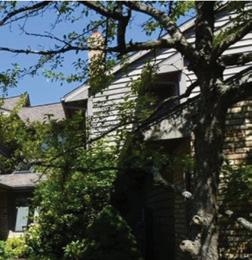




Africans and Mixed Race or “Coloureds” were eligible to be elected representatives, they could observe in Parliament but couldn’t vote. As we walked toward the “Arch,” built to honor the late Reverend Desmond Tutu, Cape Town’s Anglican Archbishop who was integral to the anti-Apartheid movement, I realized Government Ave. is also an impromptu entertainment venue. Beautiful harmonies wafted our direction and we saw joyful groups of young people singing acapella and dancing to African rhythms. It turned out they were from Lesotho and Christie praised them in Sotho, her second language. After a cozy lunch at Labotessa Luxury Boutique Hotel, I was dragging. To my regret I passed on visiting Kirstenbosch National Botanical Garden and returned to Hotel Verde for a much-needed massage.
The entire group headed off the next morning for Kalk Bay, a quaint fishing village on what sailors called False Bay because they confused it with Table Bay to the north.
We spent the next three days adjusting to local time, checking out S. African penguins (sometimes called “jackass” penguins for their donkey-like bray) at Boulders Beach and going to Cape Town’s Victoria & Alfred waterfront to catch the ferry to Robben Island, where Nelson Mandela spent 18 of his 27-year confinement. Tours of Robben Island are very moving and the story of Mandela and other anti-Apartheid leaders’ time there starts with videos on the ferry. Right now, visitors are likely to have a guide who was a formerly incarcerated political prisoner. Our guide was Jama Mbatyoti, who was arrested for participating in the 1976 school (Soweto) uprisings where Black students protested the government’s mandate that all instruction be in Afrikaans. Jama spent five years there and said he could never find a job until the prison closed and hired him as a guide in 1997. Another reason to go now: Sadly, these former political prisoners are dying off. To say their lives were cut short is an understatement. Mandela, along with other leaders, was separated from the general population, ostensibly to keep them from conspiring, and worked in a limestone quarry.

They all died from lung diseases. In the not-so-distant future, Robben Island guides will likely be reading from a script about an era they’ve studied but not experienced. South Africa is known as a premier winegrowing destination. Part of the reason is a group of Huguenots, Protestants fleeing Catholic persecution in France, landed in 1688. Many of them were experienced farmers and some even brought French vines with them. They settled in the Franschhoek Valley (it means French Corner) where they planted their vines. The town of Franschhoek is adorable
and boasts 40-plus area wineries; plus it has an interesting Huguenot Museum and Memorial Monument dedicated to the Huguenots’ cultural influences in the Cape Colony and ultimately all of S. Africa. There’s a wine train that takes visitors to numerous tasting rooms. Our group split up on and sampled wines at various locations, some with stunning views of the entire Valley (Dieu Donné Vineyards.) Don’t miss tasting S. Africa’s signature variety, Pinotage, a blend of Pinot Noir and Cinsault grapes. The town of Franschhoek also boasts some of the country’s best restaurants. We dined at two of
them: The French Connection and Cafe du Vin, where I had a delightful conversation with a Black African sommelier. Our last Western Cape stop is truly an overlooked location for most S. African tours, the tiny town of Tulbagh. Long inhabited by Bushmen and Khoi-San peoples, Tulbagh was settled by the Dutch and Huguenots some 300 years ago. In 1969, a devastating earthquake destroyed most of Tulbagh’s classic Dutch Cape Colonial architecture. There was a major reconstruction effort to rebuild the town’s main street. Now visitors may amble along Church Street and tour some of its 32 historic buildings, including the Earthquake Museum, the Victorian House Museum and Pioneer House Museum. Don’t miss dinner at Reader’s Restaurant. Built in 1754, this was the home of the school teacher who read letters and documents to illiterate villagers. The night our group dined there, we met two lovely musicians, the Palm Strings Duo, from Cape Town. They invited us to hear them play guitar and violin the next day at nearby Paddagang’s Wine House & Restaurant for a Mother’s Day concert. Readers is the kind of place where the house cats may jump in your lap for feline affection. Paddagang’s has a tranquil, vine-covered patio and offers a full menu of Boland and Cape Malay cuisine plus an extensive wine list from Tulbagh Valley producers.
As we rode back to CPT to catch an incountry flight to Durban and begin our Kwa Zulu Natal Province adventure, I wondered how it would compare to the gorgeous city of Cape Town and the charming hamlets of Franschhoek and Tulbagh. I was about to learn how SAA’s trip is designed to keep reaching higher crescendos.
For more information about South African Adventures, LLC, please contact Jan Kious at (216)534-6172 or jkious2022@gmail.com. For more information about pre or post-trip tours of Cape Town, see www.vineyardadventures. co.za. As of this writing, SAA’s next trip from October 18 to November 7, 2024, still has availability.

















On Saturday, May 4, Lawrence School hosted “Bloom,” its signature fundraising event with a springtime flair. The evening brought 300 guests to the Upper School Campus in Sagamore Hills, raising over $425,000 for need-based tuition assistance for about 100 students at any grade level.
Guests donning floral print and bright hues entered the school with views of student artwork and other vibrant displays lining the halls, including an original watercolor by Canadian artist Carolyn Gavin. Under the direction of Lower and Upper School art teachers Jason Sepsi and Joy Hall, Lawrence students recreated the painting, with each piece showcasing a student’s unique handiwork. Parents and faculty placed beautiful paperand-tulle flowers throughout the school, led by parents Laura Jones and Sheila Norwood.
Established in 1993, Lawrence School helps students with learning differences – unique ways of processing information – to achieve their potential.
“When students come to Lawrence, they often arrive truly believing they can’t achieve,” said Head of School Douglas Hamilton, who has been a part of the Lawrence community for 34 years. “But with our small class sizes, specialized instruction, they reach their academic goals and then begin reaching for the
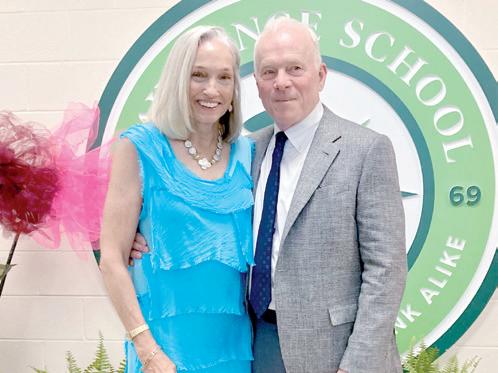





stars both in and outside of the classroom.”
Jennifer Kaufman, board member and mother to a 2023 Lawrence graduate, Charlie, said her son experienced the transformative power of the school.
“Here, Charlie encountered something revolutionary – positive reinforcement from his teachers and his peers who understood him. He learned in a way that worked for him in an environment that embraced his unique learning style,” Kaufman said. “Seeing him flourish was a joy beyond words – a huge sigh of relief as his mom,” she added. “Many of you know exactly what I’m talking about.”
“Many students with learning differences are not able to take advantage of a school like Lawrence,” Kaufman said. “What we just witnessed here tonight is the growth of our community because all of you have allowed the future of our students to be secure.”
Guests were treated to a spirited performance of the high school band and choir, which received a standing ovation as well as applause in American Sign Language. The four-course dinner included short rib beef Wellington and chicken. Auctioneer Bob Hale led the program, complete with a raffle giving $15,000 to the winner. Students decorated their lockers for a silent auction in that room. STORY AND PHOTOS BY
ANASTASIA NICHOLAS


Finding the right home care can relieve your stress. In today’s world stress is a major factor in our daily lives, no matter how hard we try to make the right decisions, we cannot always be sure of our choices. A decision you might face is how to care for a loved one who has recently become ill or has had a health decline. Do I care for them at home by myself or not? It is difficult to watch them decline. Sometimes, it is so subtle we do not see it and other times we ignore it hoping it will improve or go away. We live with the guilt of not being there or the fear of our loved one not receiving the right care. We all have that nagging feeling no can care and love our family as we do. Not only is having that feeling stressful, but the work of being a caregiver can be difficult. Many times, we translate that stress to our loved ones, compounding the situation. Caregiver burnout can happen quickly, and it results in a change in the relationship for a spouse, son or daughter. The family caregiver’s health can suffer too. Sometimes, the best thing we can do for our loved one is to find professional home care assistance. Though no one can replace family, there are people who dedicate their life to the care of those who cannot care for themselves. Rent A Daughter Senior Care Services can provide a professional vetted caregiver. We are here for the care you need. Our caregivers can be with a loved one for a few hours, for a day or up to 24/7. Our care includes rides to appointments, shopping, cooking, light housekeeping, laundry, bathing, dressing, incontinence care or simply companionship. Our goal is to keep your loved one as independent as possible. We want to create a sense of security for your family. Choosing home care can reduce your stress and allow you to be a family member again and not a caregiver. From our heart to your home, your family is our family. Call 216.633.3604, 216.364.1111 or email Nadine at rentadaughter.org.


“The Finest in Fashion”
3067 West Market St. Fairlawn, OH 44333 330-864-6116
Monday - Friday 11-6 Saturday 10-5







Crepe Column Gown With Organza Ruffle shown in navy also available in cobalt and hot pink.


Please call for appointment for evening gowns

By CYNTHIA SCHUSTER EAKIN
Relive 100 years of special moments at an exhibit celebrating the centennial of the Summit County Historical Society.
“You are Cordially Invited: A Century of Wedding Dresses,” is on display at the Perkins Stone Mansion through July 27. The exhibit, curated by Denise Remark Lundell, features more than 70 dresses relating to local individuals connected to the society. From staff, volunteers and board directors and members, neighbors and past artifact donors, the display highlights the lives and styles from the 1920s through the 2020s.
Denise Remark Lundell started recruiting apparel and artifacts for the display last year, building to the momentum for the society’s celebratory year. “This is actually a two-part
project, because 2024 is the 100th anniversary of the founding of the Summit County Historical Society,” she noted. She said that assembling the exhibit, which began around Christmas, took more than 500 hours to complete. She extends her thanks to committee volunteers Karen Clark, Mary and Jack Schifano, Janet Taylor, Janet McCauley, Lydia Bozeman, Theresa Beyerle, Katie Carney, Buff Darkow, Teresa and Joe Coral, Eva Manbeck, Kim Schreckenberger and Linda Werntz.
One of the committee members discovered that Sherwin-Williams has charts of popular colors listed by decades. “We feature a chart of their color palette from each era in the individual rooms and found that they are right on,” Remark Lundell said. Each room in the historic Perkins Stone Mansion, the home of Akron and Summit County’s founding

You have the vision. We have the expertise. Landscape Renovations, New Plantings, Paver Patios/walkways, Fire pit installation and much more. J&D LANDSCAPES, LLC, 440.834.4443 or visit JDLandscapesLLC.com.
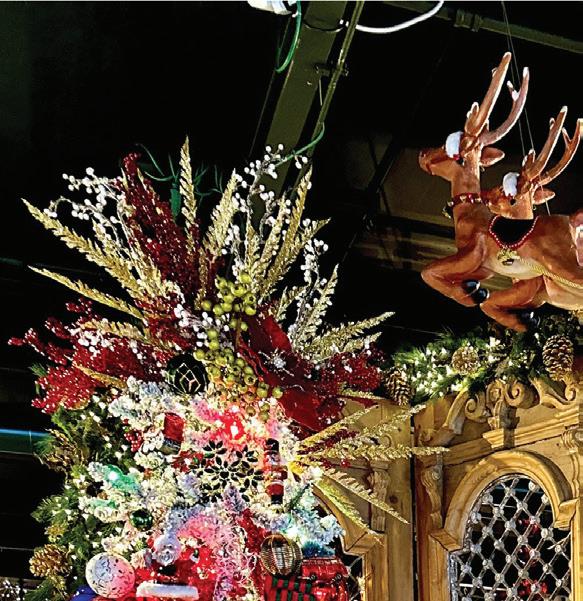

family, is set to a different decade. The exhibit committee felt that the juxtaposition of time and space would make an impact on visitors and be a homage to the past and the present.
Contributors to the exhibit include Veronica Brown Sims, the 33rd District Ohio State Representative, who shared her dress, veil and train that is on display by her wedding photograph in the front hall, greeting guests as they begin the tour. Karen Clark has volunteered at the society for 25 years, working extensively with the society’s president Leianne Neff Heppner on past exhibitions. Besides her knowledge of steaming and prepping vintage clothing, Clark loaned almost 20 dresses from her family that include those worn by herself, her mother, her three daughters and her granddaughter.
Accompanying the beautiful, unique and
amazing dresses are veils, some with cowboy hats or pill boxes, shoes, wraps, gifts and even some romantic-wear. The stories will warm your heart and cause visitors to wish for more time to learn about the women who wore the dresses and the families they united with their marriages. July tours take place Wednesday through Saturday. Admission is free for Summit County Historical Society members. Non-member ticket prices are $15 for adults, $10 for seniors and veterans/military, $5 for students and free for children age six and younger. Purchased tickets include tours of both the Perkins Stone Mansion and the John Brown House, the onetime rented home of the famed abolitionist. To learn more about the Summit County Historical Society, visit www.summithistory.org.



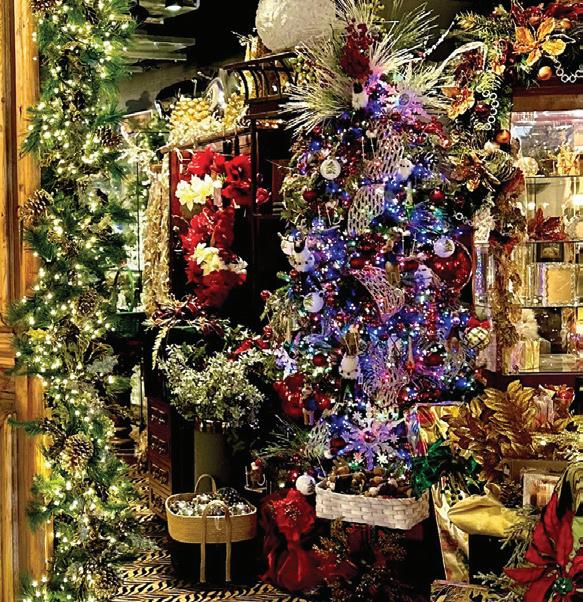

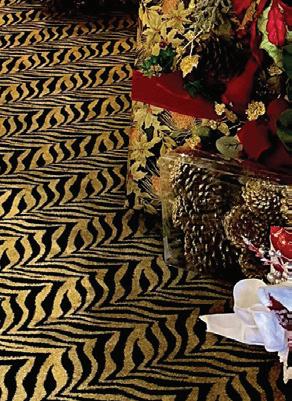



The Alzheimer’s Association Cleveland and Greater East Ohio Area Chapters’ 2024 A Celebration of Hope Gala brought together community leaders, supporters and partners united in the fight against Alzheimer’s to raise more than $670,000 - marking the most successful event ever and making it one of the top Association galas in the United States.
The annual event supports a variety of Alzheimer’s Association initiatives, including free care and support, research and advocacy. The evening was emceed by WKYC’s Laura Caso and presented by Barb and Brad Sacks.
“A Celebration of Hope is a wonderful chance to celebrate our shared mission – a world without Alzheimer’s – with our most passionate supporters,” said Melissa Zapanta Shelton, executive director of the Alzheimer’s Association Cleveland Area and Greater East Ohio Chapters. “We are more hopeful than ever that we’re working toward a cure, and the event directly impacts the free programs and services we’re able to offer Northeast Ohioans every day.”
Alzheimer’s Association board member
Bill Herzog of Bratenahl was honored with the Champion Award in recognition of his leadership in the fight to end Alzheimer’s. From launching the Ashtabula Walk to End Alzheimer’s in 2020, to hosting one of the leading The Longest Day events in the nation and serving as a member of the Cleveland Chapter’s Board of Directors, Bill has made it his mission to support families facing the disease, while raising funds to advance critical research. Prior to moving to Bratenahl, Bill was born and raised in Ashtabula, owned an insurance business, raised a family there and was involved in local government.
“Bill is a shining example of a dedicated and passionate volunteer,” continued Shelton. “We are truly grateful for his endless support and were so pleased to honor him surrounded by his friends, family and supporters.”

The event’s platinum sponsors were Covia Corp, The Herzog Family Foundation and The Sherwin-Williams Company. Gold sponsors include Vicki and Ben Brigeman, Cleveland Alzheimer’s Disease Research Center, Deloitte, Diane and Tom Detelich/Grandview Homes, EconoChannel, Tim Eippert/Stratus Unlimited, The House of LaRose, Barbara and Alan Rosskamm and Karen and Dan Tuleta.
Nationwide, one in three seniors dies with Alzheimer’s or another dementia. In Ohio, there are 236,200 individuals over the age of 65 currently living with the disease, according to the Alzheimer’s Association Facts and Figures report.
Those concerned about themselves or a loved one can contact the Alzheimer’s Association Cleveland Area Chapter at 216.342.5556 to schedule a care consultation and be connected to local resources. STORY AND PHOTOGRAPHS SUBMITTED BY ALZHEIMER’S ASSOCIATION.














Golden pianos to appear in iconic Cleveland locations for 50th anniversary celebration
In celebration of the 50th anniversary of the Cleveland International Piano Competition (CIPC), Piano Cleveland has placed six golden pianos in prominent—and sometimes unexpected—locations throughout the city. The golden pianos are part of the “50 Days of CIPC,” a lead-up to the competition’s signature Final Concerto Round with The Cleveland Orchestra. This initiative, generously sponsored by KeyBank, will feature weekly pop-up concerts at each of the piano locations.
“We did similar piano placement projects in both 2013 and again during the pandemic in 2021,” says Marissa Moore, Executive Director of Piano Cleveland. “Both times we placed these pianos in nontraditional spaces, we saw the transformative power of music. We’re thrilled to once again bring piano music out of the concert hall and into the city.”
As part of the installation, Piano Cleveland is hosting 30-45 minute pop-up concerts with local pianists at each site. When the pianos are not being used for scheduled performances, Piano Cleveland encourages pianists of all levels to play. “These instruments are meant to be played,” says Moore. “We are encouraging people to post videos of themselves performing using the hashtag #PianosInTheCity.”
Locations for the golden pianos with public performance times are:
Cleveland City Hall, Thursdays at noon
Playhouse Square’s Connor Palace, Fridays at 6 PM
Tower City (outside The Eatery), Thursday, July 18 at noon
Market Hall at Van Aken District, Sundays at 9 AM
Pivot Center, Sundays starting July 14 at 1 PM
Cleveland Public Library Main Branch, Saturdays at noon
(Several locations such as City Hall and Tower City are booking additional performances.)
For more information about the Cleveland International Piano Competition and Piano Cleveland, including its history, past and present contestants, competition dates, and performance venues, visit pianocleveland.org/.
“There’s
No Place Like Beck Center”
“There’s No Place Like Beck Center,” a fundraiser marking Beck Center for the Arts’ Youth Theater’s 75th anniversary, was an evening of fun and entertainment attended by more than 225 guests.
The event reflected on the history of Beck Center’s Youth Theater, the longest running program of its kind in the United States. It celebrated the critical impact of the arts on young people’s lives in the past as the institution looks to the future.
“Generations have come through our doors since 1949 when Virginia Woodworth, Dorothy Sanders and Jan Egert formalized the Children’s Theater program,” Beck Center President and CEO Cindy Einhouse said. “They were dedicated to helping children become comfortable with the spoken word. As Jan Egert said, ‘It has to begin in their childhood. You have to become comfortable with the spoken word or as adults we are not able to describe how we feel or what we think. There is a lot of creativity in children that has to be brought out.”’
The fundraiser included a concert performance in the Senney Theater featuring Beck Center’s Youth Theater students and alumni performing selections from The Wizard of

Sinchak, Concetta Kuluris, Julie Gilliland and Tom Kuluris
Oz, The Wiz and more. A pre-show reception was held in the center’s newly created Studio 201 dance rehearsal space. Proceeds from the benefit will advance Beck Center’s mission to provide arts education, performances, exhibitions, creative arts therapies and community programs to people of all ages, skills and abilities. Beck Center for the Arts offers more than 200 classes a week for people of all ages and serves individuals in five counties.
STORY BY CYNTHIA SCHUSTER EAKIN/ PHOTOGRAPS BY ERIC EAKIN





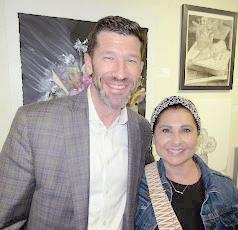









On June 1, the Allen Theatre evoked revelry and renewal for the 300 guests at the Cleveland Play House (CPH) Annual Gala. Its Renaissance theme signaled the return of the gala after a five-year hiatus.
Throughout its rich history, dating back to 1915, Cleveland Play House has been committed to building a better community through theatre. It inspires and entertains diverse audiences in Northeast Ohio by producing plays of the highest professional standards, and proudly serves as America’s longest-running professional regional theatre.
With its education programs, it has reached an estimated 1.5 million children since 1933, primarily students of the Cleveland Metropolitan School District.
The fundraising event honored longtime CPH supporters Roland and Dale Anglin, as well as Paul E. Westlake, Jr, of the architectural design firm, DLR Group. Roland Anglin is currently professor of public affairs at the Maxine Goodman Levin College of Public Affairs and Education at Cleveland State University, and his wife Dale is the inaugural Director of Press Forward, a national initiative to support the revitalization of local news. Westlake, whose prior firm Westlake Reed Leskosky merged with DLR Group, was involved in the renovation of the 514-seat Allen Theatre in 2012. Artistic Director Michael Barakiva and

Managing Director Rachel L. Fink presented the evening’s awards to its honorees.
Guests enjoyed cocktails and appetizers while wandering artists from Inlet Dance Theatre and violinist Maestro Flux entertained. Drag Queens Samantha Echo, Erica Martinez, Dr. Lady J and Empress Dupree greeted guests. Christopher Kascsak of Design Studio Cleveland created a visually stunning dining room in the Allen Theatre lobby complete with candelabras, floral displays, and bold green and purple lighting.
Michael J. Meehan, Board Chair, along with CPH staff and company members of the musical “In the Heights” opened with a witty musical number on stage with song and dance. Board member Colleen Longshaw Jackson performed a comical take on a favorite “Fiddler on the Roof” song encouraging guests to give generously. “If I Were a Rich Man” became “If I Were a Rich House” as she sang alongside Playhouse Square President and CEO Craig Hassall and renowned actor/playwright Peter Lawson Jones. “Fiddler” opens May 3, 2025, at CPH as part of its 2024-25 season.
Following a live auction and Fund-A-Need, guests enjoyed buffet dinner stations with food by Driftwood Bars & Catering. The Apostle Jones band rocked the dance floor with their popular covers of pop, soul and dance tunes.
STORY AND PHOTOGRAPHS BY ANDREA C. TURNER
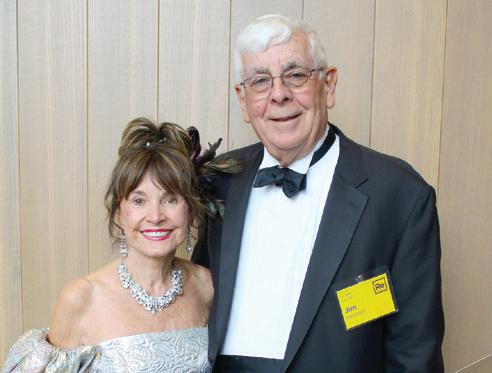
Chagrin Valley Little Theatre to host popular annual “Murder by the Falls”
Chagrin Valley Little Theatre will commence its 95th consecutive season with the annual Murder by the Falls event on September 6 and 7. This event has served as CVLT’s season kickoff fundraiser for over 30 years and marks the official beginning of their exciting 2024-25 series, which includes three musicals ( The Sound of Music, Jersey Boys, and Freaky Friday) and three plays (Erma Bombeck: At Wit’s End, Agatha Christie’s Murder on the Orient Express, and Clue: On Stage).
Murder by the Falls has grown in popularity over the years, often selling to capacity. The fun begins with a pre-show reception at 5:30 p.m. with hors d’oeuvres and a wine/ beer cash bar. The curtain rises on Act I at 7 p.m., where the story, suspects, and crime are revealed through the on-stage performance.
This year’s script, A Deadly Inside Scoop, is based on the mystery’ novel by the same name. The book was penned by Abby Collette. The stage adaptation was written for CVLT by Andrew Rothman. The book is part of Collette’s “Ice Cream Parlor” mystery series about a millennial who returns to Chagrin Falls after earning her MBA to take over her grandparents’ historic ice cream shop. The first installment of the series finds the main character racing to solve a murder in her own backyard while trying to keep the police from suspecting her father.
Tickets for Murder by the Falls are $55 and can be purchased online 24/7 at CVLT.org or by calling the Chagrin Valley Little Theatre Box Office at 440-247-8955, Tuesday - Friday afternoons from 1 to 6 p.m. Early reservations and arrival are highly recommended, especially with a major reconstruction of the bridge above the Chagrin Falls underway. CVLT is located at 40 River Street in Chagrin Falls Village.















and
greewaldantiques.com
Hale Farm & Village is a living history museum operated by the Western Reserve Historical Society and is within the boundaries of the Cuyahoga Valley National Park. Explore 19th century life in the Western Reserve including 32 historic structures, craft and trade demonstrations, farm animals and gardens. Summer at Hale Farm & Village includes these special events:
Fuel Cleveland | July 27-28
Civil War Weekend | Aug 10-11
Made In Ohio Art & Craft Festival | Aug 30-31 and Sept 1
La Macchina Molto Bella Auto Show | Sept 22
Hale Farm & Village is located at 2686 Oak Hill Rd., Bath, 330.666.3711. Visit wrhs.org for more information.
Centered around an active, fulfilling senior lifestyle, Hamlet at Chagrin Falls offers a desirable location, flexible living options and newly upgraded residences. Every day at this close-knit community presents a vibrant array of experiences and activities to help our seniors enjoy all of life’s seasons.
First established in Chagrin Falls in the 1960s, Hamlet’s leaders were intentional about creating a welcoming senior living community set on 47 wooded acres that would serve area seniors for generations to come. Their goal was achieved, and Hamlet has continued to evolve in its options for local seniors – first completing a $2 million revitalization plan and most recently, opening a new memory care neighborhood.
Hamlet’s expansive campus is the setting for both freestanding villas and spacious apartment homes. Through recent renovations, many of the community’s flexible floor plans now feature upgraded finishes and refreshed spaces. Residents appreciate the community’s simplified lifestyle
with no need to worry about meal preparation, property taxes, or snow and trash removal
Hamlet’s close connection to the surrounding community is truly one of a kind – residents are easily able to enjoy all of the unique opportunities and cultural experiences provided in the beautiful village of Chagrin Falls. However, residents also remain happily occupied within Hamlet’s picturesque campus embracing as many opportunities as possible – from yoga classes and gardening to entertainment events and happy hours hosted in The Atrium and Clubhouse.
As a not-for-profit, full-service rental senior community, Hamlet provides greater flexibility and freedom while relieving residents of the extensive chores and additional costs of homeownership – which means more time and energy to spend enjoying new friendships and the incredible valley views.
We invite you to visit Hamlet and experience our beautiful independent living apartment renovations firsthand.

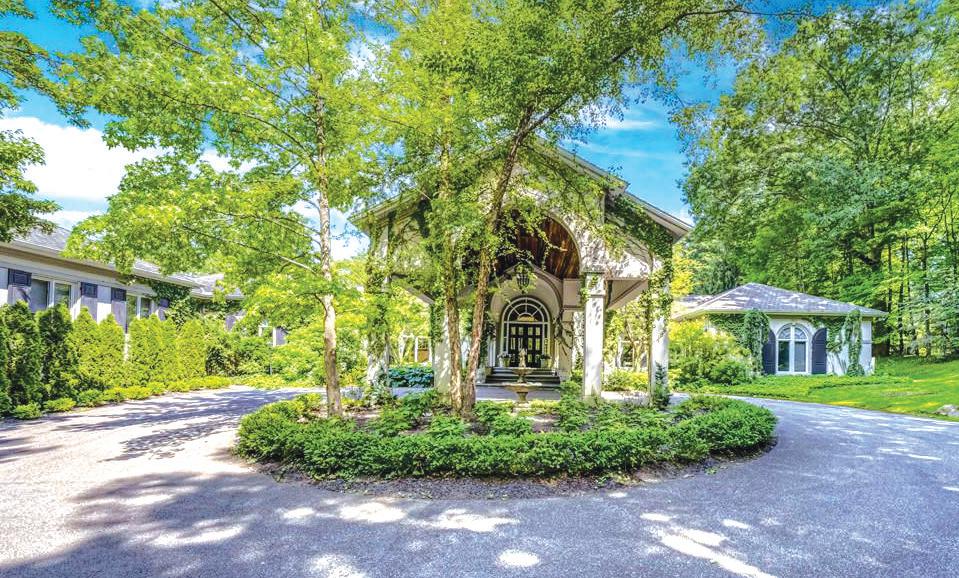











Dancing Wheels Company & School held its 43rd season gala at Playhouse Square’s Allen Theatre on June 15, for nearly 300 guests, with a world premiere concert titled, “Allies in Action.”
The event included a VIP cocktail reception with entertainment by the Coastliners of the North Coast Men’s Chorus, as well as a donation ask, silent auction and school scholarship recipient recognition.
Founded by Artistic Director Mary VerdiFletcher in 1980, the dance company has been a pioneering force in the development and success of physically integrated dance worldwide for more than four decades. It is America’s first and foremost professional physically integrated company with a composition of professional stand-up and sit-down (wheelchair-bound) dancers. Branded as the World Center for Integrated Dance & Arts Access, the company tours globally to more than 50 cities presenting dance works to audiences of 50,000 or more per year. The school, which opened in 1990, is the only multi-arts school in Ohio focused on inclusive classes in dance, movement and theater for children and adults.
The theme of allyship honors the accomplishments and support of artists in the LGBTQIA+ community whose work has paved the way for merited recognition and equality in the arts, despite facing discrimination and discourse.
Choreographers Alexis Diggs, Tiffany Mills, Mark Tomasic and company member McKenzie Beaverson presented works on the professional company members. Sara Lawrence-Sucato, Director of Education led the Performance Ensemble of school students in a piece titled, “Find Your People/I Need You.” Ross Cameron, Board Chair and Robert Solich, Event Chair welcomed guests at the start of the stage performance. Craig Hassall, President and CEO of Playhouse Square spoke of the incredible work Dancing Wheels does to present inclusive arts in all aspects of participation, arts education, performance and choreographic advancement. Celebrity guest Christi Paul, WKYC-TV Channel 3 news anchor, recognized the bravery of the performers despite some of their disabilities, and emphasized that each and every artist deserves equality.
Following the performance, DJ Jeremy James spun disco sounds on the dance floor for a champagne and dessert after-party in the lobby with the artists. For more information about Dancing Wheels, visit dancingwheels. org. STORY AND PHOTOGRAPHS BY ANDREA C. TURNER


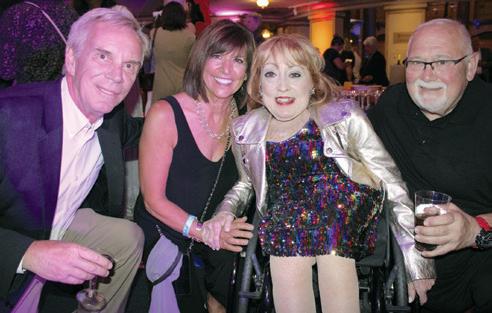
Strolling along past the historic architecture of downtown Chagrin Falls is as close as you can come to immersing yourself in a Norman Rockwell painting. The city’s charm is on full display during the summer months, especially during its annual sidewalk sale from July 25th- 27th, where one-of-a-kind boutiques, art studios and other merchants offer great deals for people hunting for unique finds. From handmade jewelry to curated home décor, you’ll find all kinds of treasures to suit your personality and style.
Set against the city’s namesake waterfall, Chagrin Falls has 53 shops nestled into a picturesque and walkable downtown. The sidewalk sale is the marquee shopping event of the year and offers shoppers the rare opportunity to peruse wares they’ll find nowhere else.
“Every year, people flock to our sidewalk sale to take advantage of the great deals and the array of one-of-a-kind items from some of the most interesting and eclectic shops anywhere,” said Mayor Bill Tomko. “Even people who aren’t shoppers come to enjoy the natural beauty, visit our park or Historical
Society Museum, pop into any of our many sidewalk cafes and restaurants, or enjoy live music. It’s a great time for families and people of all ages.”
In addition to appealing to shoppers, Chagrin is a foodie’s paradise, featuring 22 restaurants offering everything from farm-to-table culinary delights to scrumptious grab-and-go bakery and comfort food. Whether you’re cozying up around a table at a riverside patio, sitting down for some fine dining, or grabbing some delicious treats to eat as you stroll the city streets or the park, you’re sure to find something to whet your appetite.
Perhaps most enticing is the city’s hospitality. Maybe the most charming thing about Chagrin Falls is its people. Warm, friendly, and inviting, they seem to embrace a joy for life.
Chagrin Falls invites you to step back in time, savor culinary delights, and immerse yourself in a community that cherishes its past while embracing the present. Come for the sidewalk sale, stay for the warmth – it’s a destination that captures hearts and leaves you with fond memories.

















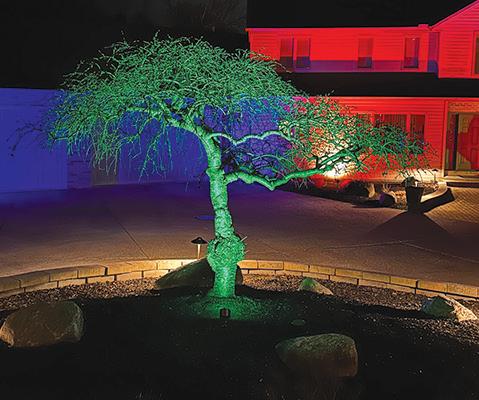










Make an unforgettable entrance in this sexy fashion-forward wedding gown from Martina Liana available at Radiant Bride. The sleek column silhouette skims over every curve. RADIANT BRIDE, Rocky River, 440.863.2000 or radiantbridecle.com.


Budget Lightscapes LED Landscape Lighting was founded 20 years ago on Quality and Excellence! Our founding legacy governs our business practices and illuminates our pathway of success. We are committed to meeting the highest of industry standards with up-to-date training, professional development, and organizational improvements. Staying at the peak of our craft brilliantly reflects our established reputation as NE Ohio’s Premier Nightscape Experts! Schedule Your Free Design Consultation/Quote: Call our office 216-406-1900, email chris@ budgetlightscapes.com or visit budgetlightscapes.com
After a five-year hiatus, The Cleveland Orchestra announced its popular Summers at Severance series will return to Severance Music Center with Thursday night concerts on July 25 and August 15. Individual tickets are now on sale. Guests can experience the perfect evening of music in one of the world’s most beautiful concert halls and enjoy pre-concert cocktails on the picturesque front terrace. Guests are encouraged to arrive early to enjoy happy hour specials and the view of University Circle.
On July 25 at 7 p.m., Czech conductor Petr Popelka contrasts Dvořák’s folk-inflected “Sixth Symphony” with Franck’s “Le Chasseur maudit,” an orchestral thrill ride that depicts a count’s fateful hunt on the Sabbath. Acclaimed violinist
James Ehnes caps the program with Korngold’s “Violin Concerto,” which brings the sounds of Hollywood film scores into the concert hall. On August 15 at 7 p.m., Music Director Franz Welser-Möst and The Cleveland Orchestra mark the 200th anniversary of Bruckner’s birth with his magnificent “Fourth Symphony” before taking it on tour in Europe. Complementing this is Mozart’s “Haffner” Symphony, an exuberant work that presents the composer at the height of his symphonic powers. Contact the Severance Music Center Ticket Office by calling 216-231-1111 or emailing boxoffice@cleveland.com. Tickets and packages can also be purchased online at clevelandorchestra.com/summersatseverance.



By CYNTHIA SCHUSTER EAKIN
Imagine trying to move your family to a new home where there are no stores, no schools, no houses, no doctors and no paved roads. Then, tell them that it is an eight-week walk to get there.
Those are just a few of the obstacles that faced Northeast Ohio’s early settlers. Catherine Burke Flament, president of the Bay Village Historical Society, talked about some of those challenges in a presentation to the Cleveland Herb Guild titled, “Gardens and Beyond in Colonial Times.
Flament noted that Joseph Cahoon, one of the first residents of Bay Village, took three moves and 11 years to finally bring his wife Lydia and eight children to Northeast Ohio from Vergennes, VT. The Cahoons had a wagon loaded with their belongings led by four horses, with an extra horse for the women to take turns riding while holding a young child. It took them eight weeks to walk to their new home. They arrived in October, 1810, and out of necessity of the season built a cabin in four days. The cabin was located on Cahoon Creek near the lakeshore. They built a grist mill in 1813, followed by a sawmill. The family lived in their one-room cabin for eight years until they were able to build a permanent residence,
which became known as Rose Hill.
When the Cahoons first arrived, they traded with native Indians at a nearby trading post. The Indians were friendly and supplied the family with raccoon fat for frying, venison, bear and maple syrup.
Flament said that the first year in Northeast Ohio was the most difficult for the Cahoon family. Since they arrived in the fall, they were unable to plant a garden. Most of the plants that they used for cooking were foraged. Foraged foods included acorn meat and cattails, which are edible marsh plants, chicory, dandelions, fiddlehead fern, maple tree helicopters, mushrooms, paw paw fruit, rose hips, spruce tips, berries and the taproot of Queen Anne’s Lace, which is a type of wild carrot.
According to Flament’s research, spruce needles were used by the indigenous people to treat coughs and sore throats. Yarrow was used for tea, as a cold and flu remedy, and to make shampoo and mouthwash. Wild violets were used in salads, sauteed and steamed. Flament noted that maple syrup production from tree sap can be traced to the Pre-Columbian Era. Ohio is still the top growing producer of maple syrup in the United States.
Dandelions were an integral part of the colonial diet. It was believed that dandelions were not only

highly nutritious but that they removed toxins, boosted the immune system, acted as a liver cleanser, helped to treat anemia, controlled blood sugar, and protected against skin damage from sunlight, aging and acne. Dandelions were also used to treat chronic ulcers, joint stiffness and tuberculosis. Dandelion blossoms added a bright floral flavor to salads and the petals were sprinkled over grilled meats and vegetables as a garnish.
Clearing the land for planting was difficult because of the abundance of large trees, Flament said. The first gardens were planted between the stumps of cut trees. Pioneer families planted kitchen gardens as soon as possible upon arriving in the area. These gardens were situated close to the cabin and planted with an eye for efficiency. They were vital to survival over the winter.
The early settlers took gardening tips from the Indians, such as planting corn, beans and squash
together. They traded seeds with the Indians and with each other. The seeds were considered to be very valuable. Flament said that it was the task of every pioneer woman to gather herbs that could be used for poultices or medicine. Herbs became more plentiful as they became a more important part of everyday life and the settler’s culinary habits. Eventually, sweet smelling herbs were planted near the house, with onions and garlic in the back of the garden. Flower gardens were planted in front of the cabins, with willow fencing to ward off predators.
Flament said that another early Bay Village resident, Seldon Osborn, studied plants as medicine. He had many recipes for remedies, which he wrote out in longhand. She noted that the Bay Village Historical Society is fortunate to still have this recipe book of herbal medicines in its collection at Rose Hill Museum.






Erma Bombeck, the American humorist once said: “Volunteers are like yachts. No matter where they are, they arouse your curiosity. Who are they? Where do they come from? Why are they here? They could stay moored where it’s safe and still justify their being, but they choose to cut through the rough waters, ride out storms and take chances.” Maybe like a yacht, a volunteer is considered a luxury. Local charities rely on volunteers to be the heart and soul of their organizations. Dedicated volunteers design their charity’s service plans and then execute their objectives.
For over 100 years, the Christ Child Society of Cleveland has identified the ongoing needs
of newborn and in-crisis children. Many new mothers receive nothing new for their baby except for a CCSC Layette, a loving bundle of infant clothing, hooded towel/washcloth, blankets, and books. Often, children enter shelters with only the clothes they are wearing. To help ease the transition, CCSC provides a “My Stuff”™ Bag filled with gender and size specific clothing, underwear, socks, and hygiene items, as well as age specific tablets, crayons/markers, and a handmade fleece blanket for younger children..
The Christ Child Society of Cleveland continues to make a difference in the lives of children in Greater Cleveland. It is because of
its amazing volunteer members that children no longer sleep on floors but now in new beds, stay warm in winter with new jackets, feel good about themselves upon receiving hygiene products at their schools, and experience the joy of reading a new book which helps build vocabulary and language skills.
The latest US census reports that only 23 percent of US citizens offer their time to volunteer and each year that number noticeably declines. Sadly, the needs of impoverished children living in our country have not declined, but instead continue to grow at alarming rates. Earlier this year, cleveland.com noted that Cleveland’s childhood poverty rate is a
shocking 46 percent. Be the yacht, the luxury, in improving the lives of these children in need. Help Us Help Them!
Informational Meeting,Wednesday, August 7 at 10 a.m.
Meet CCSC members and learn about the Service Opportunities.
Register via email or call office. Christ Child Society of Cleveland Office 7901 Detroit Avenue, Suite 300 Cleveland, OH 44102
Phone: 216-939-3859
Email: Christchildcleveland@yahoo.com www.christchildsocietycleveland.org







Envision yourself in a beautiful residence with plenty of space to enjoy — then stepping out into a close-knit community surrounded by nature’s splendor. Centered around an active, fulfilling senior lifestyle, Hamlet at Chagrin Falls offers a desirable location, flexible living options and newly upgraded residences. Many of our generous floor plans offer over 1,600 sq. ft. to make your own, and include two bedrooms, a den and two full bathrooms.
Come see how Hamlet is a natural fit for a renewed lifestyle without the hassles of homeownership. Contact us at 440-561-6466 to schedule a tour.

WHEN YOU ARE READY TO BUY OR SELL, THE ANSWER IS SIMPLE



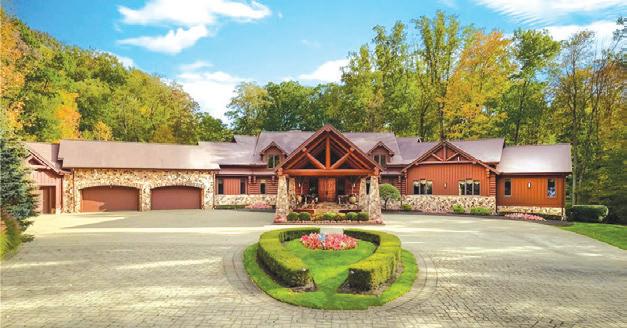
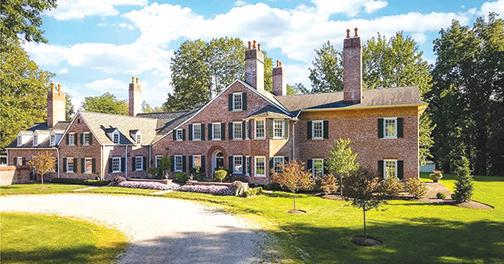
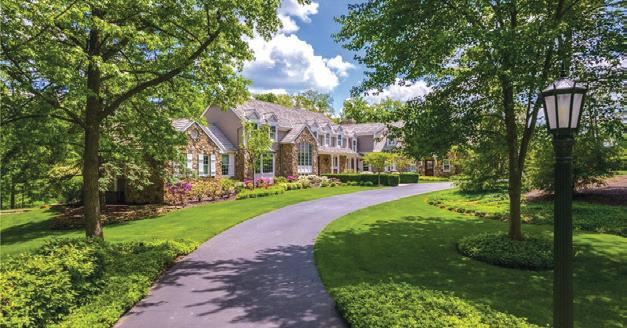



















By JEANNIE EMSER SCHULTZ
Sadly, precious few of the glorious mansions built by scions of industry during America’s Gilded Age remain. The survivors, however, are being reincarnated for uses as varied as B&Bs, museums, retirement homes, academies and eateries.
Wealthy families like the Vanderbilts, Carnegies and Astors had amassed great fortunes during the Gilded Age (1870-1910) allowing them to emulate European nobility they admired by building lavish mansions. These large, ornate homes in cities like Boston, Chicago, San Francisco and New York’s 5th Avenue Millionaires Row were generally centralized in cities.
And, like those cities, Cleveland’s own “Millionaires Row” was downtown Euclid Avenue where men of unparalleled wealth like John D. Rockefeller, Marcus Hanna and Samuel Mather resided. Baedeker’s Travel Guide even dubbed that stretch of Euclid Avenue the “Showplace of America” for its stunning elm-lined sidewalks, opulent mansions and gardens, comparing it to no less than the Champs-Elysees in Paris. Mirroring the East Coast barons, who built “summer mansions” in Newport, RI or Long Island to escape the city heat, Cleveland’s wealthy would also build large summer residences along the lake in Bratenahl and Lakewood.
But the days of the grand estates were soon numbered when both the 1913 federal income tax and 1916 estate tax made colossal manors less financially sustainable, and World War I effected difficulty in hiring servants to run the mansions. An added financial blow came via the Great Depression.
The fatal blow, however, was delivered courtesy of 1950s Urban Development. City planners needed space to introduce freeways, while real estate developers salivated over the prospect of buying estates, and even churches, to demolish them for commercial use, such as in New York City where a Vanderbilt mansion was leveled to construct Bergdorf Goodman department store.
Likewise, Cleveland’s Millionaires Row grand

be lost to the 1954 construction of the Innerbelt (with one of the few remaining converted into the University Club, then Myers University and currently the Cleveland Children’s Museum). This scenario was being repeated across the nation as wealthy families eschewed cities for the quiet privacy of the suburbs, leaving their city mansions behind.
What was to become of those grand homes that survived? Some were orphaned, falling into disrepair or repurposed as retirement or mental institutions, schools or museums, like San Francisco’s 1886 Haas-Lilenthal grand Victorian House. Once turned into a home for Jewish immigrants, as a museum today Haas-Lilienthal welcomes visitors can explore what an 1800’s Victorian home looked like inside.
In the 1960s a trend began to sweep the country to create interesting restaurants out of not only the remaining Gilded Age mansions, but other historic or architecturally significant buildings: churches, bus stations, police and fire houses, gas stations and banks.
In Chicago the 1874 DeKoven mansion
reopened as the upscale Biggs Restaurant in 1964, before transitioning to Il Mulino eatery and currently “Chicago’s finest cigar emporium, lounge and members club.” In Anaheim, CA diners visiting the 1909 landmark Anaheim White House Waterman mansion come for the food and stay for the supernatural. Supposedly several children and a woman—perhaps former residents—haunt the building with guests reporting voices, moved objects and footsteps above them.
Mansions were transitioned to hotels with restaurants include the famous Dallas estate that became the Toney Mansion at Turtle Creek, and heiress Barbara Hutton’s Newport, RI summer home, Shamrock Cliff House—now the Ocean Cliff which features the sea-view Safari Room Restaurant. (Other famous Newport mansions became museums open for public tours like The Breakers, Marble House, The Elms and Rosecliff—where movies “The Great Gatsby,” “True Lies” and “Amistad” were filmed.) Locally, in Bratenahl, the summer estate of Samuel Mather became the private Shoreby Club in 1993.
Another local mansion to recently open as an inn and restaurant is the former 1902 Willoughby mansion, originally commissioned by Julia French Boyce and designed by renowned Cleveland architect Charles Schweinfurth. The picturesque
stone manor’s history included use as an assisted living and a girl’s school before the area’s Neundorfer brothers, Mike and Paul, renovated it to become Willoughby House.
Debuting just this past April as an inn, it now boasts not only seven suites on the second floor-with Julia’s 1902 restaurant on the main floor—but with suites in the property’s converted carriage house as well.
Travelers looking for unique restaurants might opt to visit San Francisco’s Presidio Social Club. The former 1903 military barracks-cum-restaurant offers a magnificent view of the Golden Gate bridge for diners. Visitors to Savannah, GA are urged to check out another interesting eatery… the art deco architecture of the former Greyhound bus terminal that thankfully was saved to become its popular restaurant, The Grey.
Neither have churches been immune to being repurposed as restaurants (although they are deconsecrated before the transition is valid.) Pittsburgh’s Church Brew Works moved into the 1902 St. John The Baptist Church, and New Orleans’ Vessel Restaurant resides in a historic 1914 Lutheran church. But one of the most unusual is literally a cathedral of pizza—John’s at Times Square. John’s calls itself “the most unique pizzeria in the world,”and it is quite likely also the largest. Pizza lovers dine in the former New York 400-seat Gospel Tabernacle Church under its most impressive, colorful stained-glass ceiling!
While the majority of Gilded Age mansionsturned-eateries became white tablecloth restaurants, there are a few exceptions. Mansions in Freeport, ME and Hempstead, Long Island are homes to none other than the most elegant… McDonald’s! Area residents “are lovin’ it” in what the locals have dubbed their “McMansions.”
At Freeport’s 1850’s Gore Mansion and Hempstead’s 1795 heritage home, McDonald’s has preserved the aesthetics of the homes and lowkeyed the golden arches signage. Their fast-food aficionados likely never thought they’d one day be standing in the elegance of a historical landmark amid chandeliers, admiring a grand sweeping staircase while saying, “I’ll have fries with that!”






More than five hundred guests attended Nature at Night, a special outdoor event held on the grounds of the Nature Center at Shaker Lakes. This annual event is among the most smoothly run benefits on the calendar, from the valet parking to the impeccable service, and the dozen outstanding local restaurants that donate their time, resources, and talent toward entertaining patrons. From creative cocktails to passed appetizers, desserts, and a myriad of small plates – each more creative and delicious than the next – no one goes away hungry or dissatisfied.
Three live bands played throughout the entire event, including the evocative New Orleans-infused group, Slideways. Patrons had the chance to stroll or sit, mingle and enjoy not only menu items but each other’s company throughout the early evening, and into the twilight hours. The event also featured an online silent auction with culinary prizes from picnics to special occasion meals, tickets for sports and arts events, and also a raffle for a 10-day stay in Barcelona.
In a brief presentation, the organization’s first Community Spark Award was given to the Ohio Environmental Council, a partnering nonprofit that works toward clean water, clean
energy and the protection of public lands. Partnership is an important aspect to the Center – it collaborates with three cities, and multiple nonprofits to help fulfill its mission.
The Nature Center, founded nearly 50 years ago, continues to thrive as it offers accessible green space, educational programming, and inventive methods for bringing people and nature together through curated presentations, through art, and through hands-on classes. Within the 20 acres of this protected green space are eight unique native habitats that need constant conservation, a pavilion, offices/gift shop and two trails accessible to people of every ability.
Funds from Nature at Night go to general operating expenses. Costs include hosting over 140,000 visitors and 13,000 students annually. The Center also bands over 1,000 birds every year for science and migration studies.With a calendar already full, the Center is introducing Summer Wednesdays as a way to entice families to visit during extended hours mid-week.
Each Summer Wednesday will have a theme – painting or pets, or simple exploration, and events are free and open to the public, working toward its mission to “conserve, connect, and inspire.” Visit shakerlakes.org. STORY AND PHOTOGRAPHS BY RITA
KUEBER

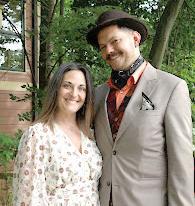
Rd.,

By CYNTHIA SCHUSTER EAKIN
Summer is in full swing. The time is now ripe to swing by your local farmers’ market to stock up on local, fresh, and nutritious foods.
The Frostville Farmer’s Market is situated on the beautiful grounds of Frostville Museum, a living history of 19th century Ohio. Customers can tour the various historic buildings while shopping the market, listen to the bands that play weekly and grab a bite to eat from the Frostville Kitchen or Elle and Cornelia’s food truck.
“We are in our 14th year and are growing by leaps and bounds. Currently, we have more than 50 vendors on the roster and average between 35 to 45 vendors each week,” Angela Obbish, market manager said. “New vendors come in almost weekly. There is a great mix of farmers and growers, food purveyors, artists and crafters. Four times a year, we hold an antique, vintage and farmers’ market event. We had one on June 15 that was a huge success. The upcoming ones will be held on July 20, Aug. 24 and Sept. 21.”
Obbish spoke with numerous vendors to ask what customers can find at the market and to inquire about what effects the weather has had on seasonal availability. Here are some of their responses.
Joey Rhoda of Lucky’s Loosestrife in Garfield Heights said that visitors to his booth at the Frostville Farmers’ Market can expect to find tomatoes, red candy onions, squash, assorted beans, peppers, blackberries, gold berries, ground cherries, cucumbers, plums, apples, possibly peaches and maybe the first melons in July through August.
“The early spring weather really caused some issues with my crops. They bloomed a solid six weeks earlier this year than the year before, which meant they were in full flower mode during two separate snow storms. Due
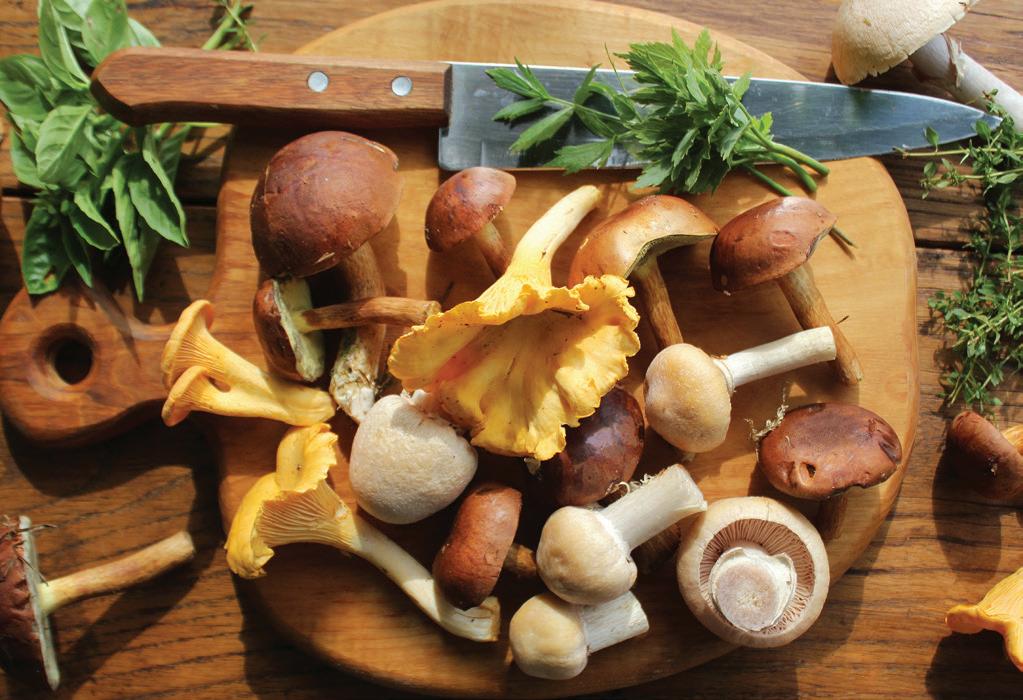
to that, I lost most of the crop and barely have any peaches this year,” he said. “And then for the market garden, my greens are essentially trashed, tatsoi and bok choy bolted within one to three weeks of planting, making it good for nothing but compost. The large heads of lettuce I planned to offer on some of my first market days bolted and turned bitter during a week of straight nineties. On the other hand, crops like blueberries and beans all fruited super early and gave heavy harvests. So, there’s some good with the bad for this odd weather.”
“I always try to grow something new every year. One of my biggest passions is fruit, so naturally I wanted more in the gardens. I’m growing a gorgeous selection of heirloom melons and watermelons this year. Some of the watermelons, like Lemon Drop, have beautiful yellow skin hiding an even deeper yellow flesh, while some of the melons, like



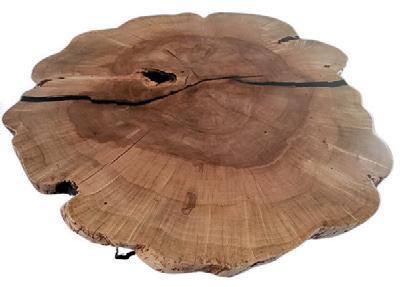

Crane and Sweet Freckles, have really cool speckled skin with bright orange flesh. Along with these, a few other new crops are gold berries, purple sugar snap peas and dragon tongue beans,” Rhoda added.
Debbie Anderson of A and D Gardens in Geneva said, “Everything is coming in early this year.” She will be selling blueberries, peaches, nectarines, beans, tomatoes, cucumbers, zucchini, eggplant, corn, peppers, pickles, cabbage, onions, cantaloupe and watermelon in the next few weeks.
Tom Bollinger and Amanda Shalkhauser of Honest Farmers Produce in Grafton said that July visitors to the market can expect to find French Breakfast radishes, regular radishes, white radishes, red and golden beets, green and striped zucchini, yellow summer squash, carrots, green beans, yellow beans, assorted cherry tomatoes, beefsteak tomatoes, Roma
tomatoes, lunchbox sweet peppers, and red and green okra.
In August, they will be bringing purple skin and purple flesh russet potatoes, purple skin and white flesh russet potatoes, German Butterball potatoes, red potatoes, Kennebec russet potatoes, slicing cucumbers, pickling cucumbers and rutabaga to the market. There will also be green, yellow, red and purple sweet peppers, sweet banana peppers, jalapeno peppers, hot chili peppers, hot banana peppers, tabasco peppers and habanero peppers.
“The early spring weather helped establish plants early. Seeds with inherently low germination rates at cold temperatures will likely produce bumper crops this summer and fall,” Bollinger said. “While the early spring helped establish plants, no year is perfect, and we have experienced the loss of some of our tomatoes, which we did have to replace because of critters, storms early on and wind. We have been getting lucky with the rain recently, but we have had days in which we have had to hand water crops to keep them alive in the heat. The groundhogs and rabbits have been an issue this year, and we have lost some beets and beans to them. We also continue to struggle with insect predation on our squash crop. We use only organic insecticides, including beneficial insects, bacteria and fungi, which can be effective but aren’t perfect.”
“Even though we had a warm spring, you can’t plant too early because you never know if we’ll get a late frost and the crops will suffer,” Rachel Wiegand of Second Spring Farm in Grafton noted. She said that she will be bringing tomatoes, cucumbers, beans, a variety of peppers, kale, onions, garlic, eggplant, squash and zucchini to the July and August markets.
“We will have garlic, various types of onions, lettuce, potatoes and rhubarb,” Bill Continued on next page



and Carol Kovacs of Dragonfly Farms and Provisions in North Olmsted said. “Crops were a bit slow in general, but garlic was actually early this year. We also have jams, apple butter, plants and flowers.”
Ken and Sandy Ressler own Elm Run Farms, a fifth-generation farm spanning 125 years in Orville. In addition to offering beef, chicken, turkey, pork, eggs and maple syrup, they have partnered with Triple Creek Farm to carry their lamb.
Kris and Evona Gaughan of Gaughan Bee Dancin’ in Medina, offer green beans, spaghetti squash, cucumbers, tomatoes, sweet and hot peppers, kohlrabi, kale, beets, zucchini, yellow squash and assorted herbs. “With the warmer weather and less rain, I was able to get the plants in the ground sooner,” Kris Gaughan said. “I was surprised to see mature vegetables already. The strawberries, blackberries, blueberries and raspberries were all early. We also have honey, whipped honey and honeycomb, along with beeswax candles and several other bee products.”
Earthly Delights Mushroom Company of Parma, operated by Colin Casteele and Zach Douglas, currently have Blue Oyster and Lion’s Mane mushrooms, along with mushroom grow kits for each. They are working on growing a couple of additional varieties of mushrooms for the market.
Neal and Cathy Klabunde of Strongsville operate Dirty Fingernails Nursery, Westwood Honey Farm and Livin’ Greens Premium Microgreens. They grow many varieties of hardy perennials, hanging baskets and nutritious microgreens that they bring to the Frostville Market, along with honey, comb honey, habanero-infused honey, beeswax candles and pollen.
Rebecca Sakaley of Shady Acres Farm Ohio in Columbia Station brings beautiful floral bouquets to the market.
Paul Kawczak of Paul’s Plants in Seven Hills sells houseplants in a variety of repurposed containers and outdoor starter plants such as vegetables, herbs and specialty plants.
Erik Misenis of Art of Sharp Ohio in Grafton, a knife sharpener, is another regular vendor at the market.
Frostville Farmers’ Market, 24101 Cedar Point Rd. in North Olmsted, is open outdoors from May through October on Saturdays from 9 a.m. to 1 p.m. The indoor market in the events barn takes place from 10 a.m. to 1 p.m. on Saturdays, November through April. Visit the market’s Facebook page at www. facebook.com/frostvillemarket for updates.
Mushrooms & Beans (serves 4-6)
(courtesy of Earthly Delights Mushroom Co.)
Ingredients:
1 onion, chopped
½ lb. mushrooms, chopped
2 15-oz. cans of pinto beans, drained
2 cloves of garlic, minced
½ tsp. cumin
½ tsp. chipotle powder
½ tsp. smoked paprika
½ tsp. ground black pepper
3 C. of vegetable or mushroom broth
14-oz. can of diced tomatoes
Salt Olive oil
Method:
In a pot or dutch oven, cook the onions and mushrooms in a small amount of olive oil until they are brown and the mushrooms are soft. Add garlic and spices and let cook for another minute.
Add pinto beans, tomatoes and broth to the pot. Bring to a boil and simmer for one hour or until the liquid reduces somewhat, stirring every 15 minutes. If you want the beans thicker, cook for another 30 minutes or until the desired consistency. Add salt to taste. Have any leftovers? Try making refried beans.
You can pan fry these in some oil and mash them up really good. We promise they will be miles beyond any canned refrieds you have ever tried.




“Summer Soiree: A New Season, Same Legacy” was a celebration of 55 years of May Dugan Center advancing lives and communities. More than 220 guests attended the event at Windows on The River. It included a buffet dinner, a silent auction, raffle baskets and music from Sound Waves Entertainment. Robin Swoboda served as emcee of ceremonies. The second annual Summer Soiree raised more than $75,000 to support May Dugan Center’s mission. The center’s core programming includes food and clothing distribution,

behavioral health services, the Education Resource Center, Seniors on the Move, trauma recovery and refugee services. The center served more than 23,000 clients in 2023 and distributed over 634,000 meals. According to Rick Kemm, May Dugan Center executive director, that need has increased this year. The expanded food pantry is now able to distribute 60 percent more meals, totaling more than 900,000 meals this year for people in need.
STORY BY CYNTHIA SCHUSTER EAKIN/ PHOTOGRAPHS BY ERIC EAKIN



Some milestones are rather personal. Others are more than worth sharing. Most especially when that milestone can be so life-changing for senior parents having difficulties with housekeeping, transportation and other activities of daily living at home.
That milestone, of course, is, Anna Maria of Aurora’s 60th Anniversary... and another great reason to have that serious conversation about finding a senior living community that everyone can feel comfortable with. And a visit to the Campus of Anna Maria of Aurora. We’re Experts at this.
Why? So many reasons: the attention, and a senior lifestyle, that provides genuine peace
of mind. Not to mention a much more sensible financial model that delivers a better way to pay for senior care.
Anna Maria of Aurora does not require upfront investments, buy backs or any such “give it all up” financing model. Anna Maria’s payment model is simple, fair and transparent. Residents pay only for what they need, and “as you go.” So, families pay month-to-month with no long-term commitments; you will never have to pay for care you may never need.
Superb care, active lifestyle
Anna Maria of Aurora offers a full continuum of care, with settings to match should the needs of your loved one change. They can
enjoy Independent Living on a lovely campus, and transition to Assisted Living without the need to move. They stay in the same apartment.
Anna Maria of Aurora can offer a Senior Living continuum of care that features fully Independent Living as well as Assisted Living ... all more focused on the needs of your loved one. So, they can really enjoy every day, “age in place” happily, and thrive physically, mentally, and emotionally.
One family, one campus, one big advantage
Anna Maria isn’t just an enterprise; it’s a family’s legacy. The Norton family has owned
and operated Anna Maria for three generations: 2024 is our 60th anniversary! And to this day, we remain one family at one campus, where every day we’re caring for – and accountable to – your family. Creating a senior community that goes above and beyond. One that holds 5-star ratings from Medicare across the board. And it’s beautiful.
This hands-on, family approach has been the key: providing the continuity that allows Anna Maria to retain staff (many of whom have been there for many years), while continuously improving and modernizing both facilities and care settings. The family holds the company motto to heart: “Every Resident, Every Family, Every Day.”



July
From July 24 to 27, the 2024 BorderLight Theatre Festival will return to Playhouse Square with four days of innovative performances sure to entertain Northeast Ohio audiences.
Established and emerging companies in theatre, circus, immersive experiences, street theatre, poetry, workshops, stand-up comedy, and more from Cleveland and across the U.S. will light up stages throughout the performing arts neighborhood.
As one of the newest fringe festivals worldwide – the inaugural event was held in 2019 – BorderLight is a platform for independent artists and companies to showcase their work and engage new audiences in a vibrant environment. In 2024 and alternating years, BorderLight is thrilled to welcome, alongside the fringe artists, several acclaimed international touring companies featuring work of diverse regions and genres.
“BorderLight Theatre Festival proudly presents a groundbreaking lineup where theatre meets societal urgency,” said Executive and Artistic Director Dale Heinen. “With two U.S. premieres, our shows delve into themes vital to our human experience, from the pressing issue of loneliness – declared a public health crisis – to explorations of belonging, racism, music, identity and love. Featuring innovative work in puppetry, physical theatre, improvisation, audience interaction and dance, these award-winning productions—some hailed at the renowned Edinburgh Festival—promise to captivate and inspire Cleveland audiences.” This year’s curated touring productions— including four international shows—include: Indigenous Liberation | Native American The Man Who Thought He Knew Too Much | France/UK Paper Cut | Israel
Perhaps, Perhaps … Quizás | Mexico Sancho & Me - For One Night Only | England
Learn more about the 2024 BorderLight Theatre Festival at borderlightcle.org, and across social platforms by following @ BorderLightCLE.
Centering Space, a retreat house in Lakewood, marked its 20th anniversary with its first Magical Journey Gala.
More than 250 guests enjoyed bountiful hors d’oeuvres, drinks, live music and a silent auction. The highlight of the evening was a live performance by renowned magician Mark Paskell. Centering Space was the culmination of a dream by the Sisters of Charity of St. Augustine and members of laity associated with Lakewood Catholic Academy. An underused house on the school campus was offered to a group of volunteers willing to refurbish it. By 2003, they set up Centering Space as a place where individuals or groups can come to center,

find peace and rest. The gardens and porch of Centering Space are ideal for stillness and meditation. Retreatants can also take advantage of the recreational facilities in Lakewood Park located just to the east. All are welcome, including women and men of faith or no faith. Small groups can use the space for meetings or mini retreats. A library is filled with books on a wide variety of spiritual topics. Centering Space volunteers recommend retreats as a way to put life challenges in perspective, rekindle your goals and to discern where your life journey is leading. STORY BY CYNTHIA
EAKIN/PHOTOGRAPHS BY ERIC EAKIN












By LINDA FEAGLER
Although it’s been 112 years since the ocean liner Titanic sank off the coast of Newfoundland on April 15, 1912, interest in the ship’s saga has never ebbed. An Academy Award-winning movie that led to a chart-topping song for Celine Dion, a Tony Award-winning Broadway musical and countless factual and fictional tomes have kept the public’s fascination fresh.
That tradition continues at the Center of Science and Industry (COSI) in Columbus through September 2 with Titanic: The Artifact Exhibition, comprising more than 200 authentic items recovered from the vessel, along with full-scale recreations of the luxurious quarters for which it was lauded. Experiential Media Group in Peachtree Corners, Georgia, created the exhibit and serves as the steward for RMS Titanic Inc., the organization that has respectfully conducted eight research expeditions to the wreck site since the late 1980s, with a ninth scheduled for this month.
“The exhibit honors the Titanic and ensures the stories of the passengers and crew continue to be told through the poignant artifacts our guests see before their very eyes,” says Kelli Kinzig, COSI’s senior project manager.
Before the Titanic left Southampton, England, on April 10, 1912, bound for New York on her maiden voyage, she was already the stuff legends are made of: a 46,328-ton floating palace filled with such then-inconceivable amenities as a Turkish bath featuring gilded cooling rooms and a masseuse; barbershops with automated shampoo and drying appliances; a hospital ward boasting a fully equipped operating room; a regulation squash court; and the first heated swimming pool ever installed on a ship.
No lightweight, Titanic’s future was thought to be one of invincibility for decades to come.
But the ship’s charted course — as well as history’s — was tragically altered at 2:20 a.m.




on April 15 when, two hours and 40 minutes after striking an iceberg, she sank off the coast of Newfoundland.
Class distinction was obliterated among the 2,240 on board. Wealthy men, such as industrialists John Jacob Astor and Benjamin Guggenheim, went down alongside third-class (steerage) passengers who scrambled in vain for one of the 1,178 spaces available in 20 lifeboats. The death toll was staggering: More than 1,500 lost their lives in the freezing Atlantic waters.
No longer would maritime safety be treated so cavalierly. A year after the catastrophe, the first International Convention for Safety of Life at Sea convened in London, resulting in a slate of new rules requiring that every ship have lifeboat space for each passenger, that disaster drills be held during each voyage and that ships maintain a 24-hour radio watch — practices still enforced today.
Each visitor to COSI: The Artifact Exhibition begins their journey by receiving a boarding pass bearing a passenger’s name and details



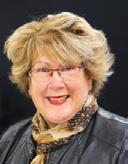



that include who they were traveling with and the purpose of the trip. At the conclusion of the exhibit, they’ll discover the fate of the person whose name they hold in their hand.
“The fact that each guest assumes the role of a passenger adds to the immersive feel of the exhibit and makes the experience personal and very emotional,” Kinzig says.
Recreations of first- and third-class accommodations and hallways and the iconic grand staircase offer a glimpse of what life was like onboard. The exhibition’s largest artifact, an 18-foot-high, 6,000-pound davit crane that lowered the ship’s lifeboats serves as a somber relic of what was to come; and it won’t take long for visitors who touch the 10- foot-high, 14-foot-long, 6-inch-thick iceberg to gain perspective on how frigid the ocean was on that fateful night as temperatures hovered between 23 and 28 degrees.
“One of the most moving artifacts people see when they enter the exhibit is an 80-pound bell, one of three from the Titanic’s Crow’s Nest on the foremast, which would have been used for timekeeping and also to sound any warnings and alarms,” Kinzig says.
“Clearly,” she adds, “it’s an object that powerfully makes its own statement.”
Although the wooden crate they were nestled in disintegrated long ago on the ocean floor, au gratin dishes from the Titanic remained pristine, and are displayed in perfectly lined rows — just as they were discovered. A deck chair is also a focal point.
But it’s the many personal items, which haven’t been completely ravaged by the decades they spent lying underwater, that visitors are understandably drawn to. Delicate paper artifacts, including pictures and postcards, are filled with detailed descriptions of the ship and the excitement surrounding the voyage ahead.
“Since many of these messages were tucked away in a leather bag or wallet, the writing on them is still legible, despite the fact they were submerged for so long,” Kinzig explains.
“Because they’re so fragile, we switch them in and out of the exhibit because they’re so light sensitive.”
Trained as a chemist, Adolphe Saalfeld was enroute to America to market the line of concentrated perfumes he’d recently created. In his haste to escape the sinking ship, the businessman left his leather sample case behind and boarded a lifeboat.
One of the 706 Titanic passengers rescued by the RMS Carpathia, Saalfeld died at home in London in 1926 at age 61. But the delightful scents linger: Several of his vials were rescued from the Atlantic, and small holes in the original case make it possible for visitors to marvel at the faint aromas emanating from it.
In “A Night to Remember,” published in 1955 by Holt, Rinehart & Winston, historian Walter Lord meticulously reconstructed what occurred during the Titanic’s final hours: From the boats, people could be seen clinging to the Titanic like little swarms of bees. The great and the unknown tumbled together in a writhing heap as the bow plunged deeper and the stern rose higher. … The lights went out, flashed on again, went out for good. A single kerosene lantern flickered high in the aftermast.
The Titanic was now perpendicular, her three dripping propellers glistening even in the darkness. Out in the boats, they could hardly believe their eyes. For over two hours, they had watched, hoping against hope, as the Titanic sank lower and lower. When the water reached her red and green running lights, they knew the end was near … but nobody dreamed it would be like this — the unearthly din, the black hull hanging at 90 degrees, the Christmas card backdrop of brilliant stars.
COSI’s Kinzig understands why the ship continues to spark interest for generations around the world.
“It’s a touching story,” she reflects, “of beauty, tragedy and hope — all at the same time.” For more information, visit cosi.org/ exhibits.






